ohiotoday
For ALUMNI and FRIENDS of OHIO UNIVERSITY
 FALL 2023
Welcoming OHIO’s Newest President The Marching Band Celebrates 100 Years
FALL 2023
Welcoming OHIO’s Newest President The Marching Band Celebrates 100 Years

 FALL 2023
Welcoming OHIO’s Newest President The Marching Band Celebrates 100 Years
FALL 2023
Welcoming OHIO’s Newest President The Marching Band Celebrates 100 Years
In the days and weeks before I assumed the role of Ohio University’s 23rd President, I had the opportunity to engage with students, faculty, staff and alumni, and I heard repeatedly how special Ohio University is. At the time, I thought everyone feels that way about their alma mater. However, since becoming a Bobcat, I now know firsthand that Ohio University truly is an extraordinary place.
Since we arrived in Athens, my husband, Randy, and I have been overwhelmed by the enthusiastic support of students, faculty, staff, alumni and friends of the University. We are so excited to be part of such a welcoming community.
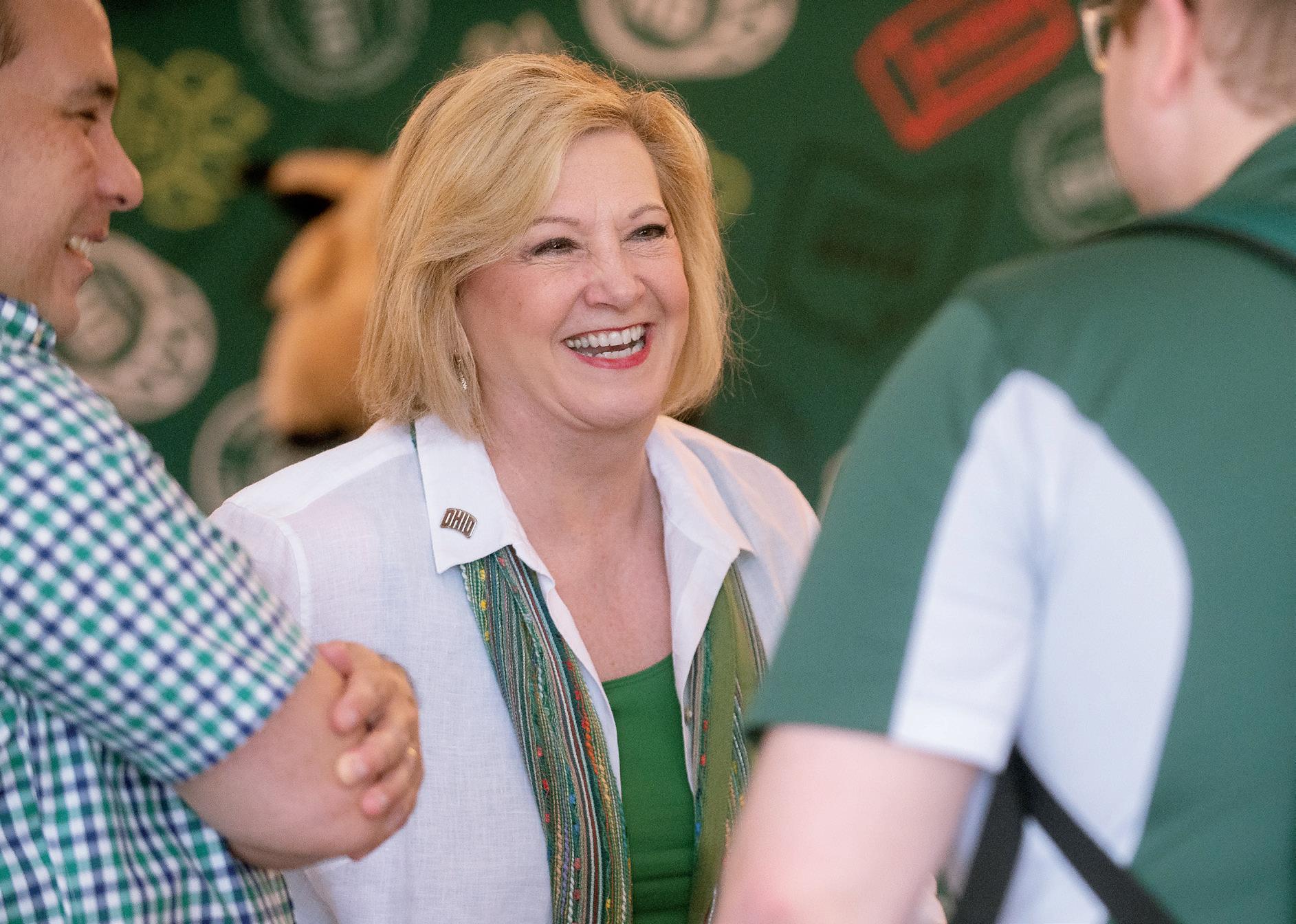
In my first days and weeks as President, I had the opportunity to tour labs and meet with faculty and staff who have dedicated their lives to the OHIO student experience. I have learned from researchers, including undergraduate and graduate students, who have made life-changing discoveries. And I have welcomed one of the largest groups of incoming first-year students in Ohio University history.
In all of this, I have learned that Bobcats believe in the power of higher education and the responsibility of giving back to the community.
I have dedicated my career to public higher education, and my commitment to each of you now is that I will champion Ohio University’s mission to ensure our students are provided with a transformative educational experience.
I am prepared to support our faculty and staff so that they can do their best work. This work includes being responsive to the needs of our communities, and Ohio University remains steadfast in its mission to serve the region. And I am excited to work with our proud alumni, united in our goal of helping Ohio University provide the best learning experience for all our students.
I am honored to serve this great institution and look forward to meeting as many of you as possible in the months ahead.
Forever OHIO,
The Heritage College of Osteopathic Medicine has been ranked among the top 50 best medical schools for primary care in the 2023-24 Best Medical Schools: Primary Care rankings by U.S. News & World Report. The rankings place the Heritage College at No. 49 in the country and No. 2 in the state of Ohio.

OHIO is reimagining arts education through the College of Fine Arts facilities renewal strategy. A combination of renovation, relocation and new construction will enable the arts to have a greater impact across the campus, community and surrounding region. Plans include a vibrant new arts center, the Patton Arts Center, as well as a renovation plan for Siegfried Hall and investments in Glidden Hall, Putnam Hall, the Sculpture Studio, facilities at the Ridges and green space.
Ohio University’s new Broadcast Meteorology degree combines science instruction in the College of Arts and Sciences with journalism coursework in the E.W. Scripps School of Journalism and broadcast experience at WOUB Public Media. The program graduated its first student in May.
Fifteen OHIO students and alumni were selected this year for prestigious awards and fellowships through the Fulbright, Critical Language Scholarship and Boren programs.
Lori Stewart Gonzalez PresidentJackie O’s Brewery selected Honey Sunrise, a beer that started as a capstone project in a University chemistry class, for the official 2023 Brew Week keg tapping event in July. The American Pale Ale was designed by Dylan Geisen for his final project in CHEM 4501 last summer.
 [ABOVE] Students at the Heritage College of Osteopathic Medicine’s Transformative Care Continuum in Cleveland. The Heritage College was recognized this year as one of the best medical schools in the nation for primary care. PHOTO BY TY WRIGHT, BFA ’02, MA ’13 [OPPOSITE PAGE] Ohio University President Lori Stewart Gonzalez meets with members of the OHIO community in her first weeks on the job.
PHOTO BY DYLAN WAYNE TOWNSEND, BSVC ’24
[ABOVE] Students at the Heritage College of Osteopathic Medicine’s Transformative Care Continuum in Cleveland. The Heritage College was recognized this year as one of the best medical schools in the nation for primary care. PHOTO BY TY WRIGHT, BFA ’02, MA ’13 [OPPOSITE PAGE] Ohio University President Lori Stewart Gonzalez meets with members of the OHIO community in her first weeks on the job.
PHOTO BY DYLAN WAYNE TOWNSEND, BSVC ’24
Meet
A look back at how the Scripps School of Journalism came to be

Alumnus Dr. Andrew Yuan’s approach to patient care is personal
OHIO’s
The Most Exciting Band in the Land came from humble beginnings
How Keith and Deborah Wandell are creating a legacy in leadership education
Members of the Marching 110 surround OHIO’s 23 rd president, Dr. Lori Stewart Gonzalez. Pictured: Back row, left to right, fifth year Logan Newhouse, BMUS, on snare drum; senior Nate Homan, BMUS, on trumpet; fifth year Melanie Jenkins, BA, on euphonium; senior Arielle Lyons, BSJ, on trombone. Front row, left to right: senior and field commander Eric Steere, BSJ, on trumpet; President Lori Stewart Gonzalez; fifth year Bailey Buell, BFA, on trumpet. PHOTO BY BEN WIRTZ SIEGEL, BSVC ’02
Visit ohiotoday.org for multimedia stories that complement the stories inside this issue
For generations, the Soldiers and Sailors monument has been an iconic gathering place on College Green. Learn about its 130-year history on page 42.
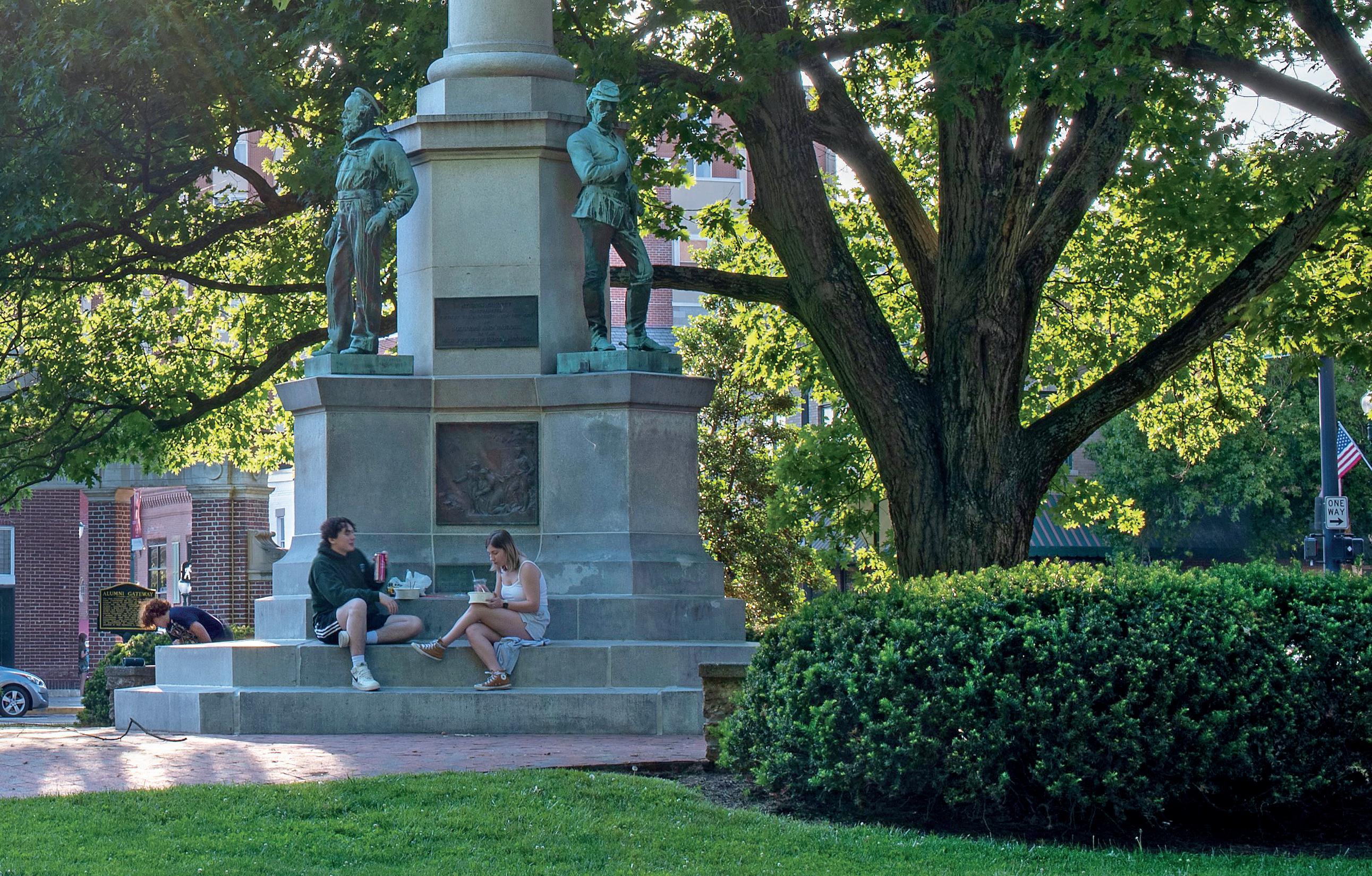
Remembering those we’ve lost I’m truly taken back this year by the losses of Coach Cleve Bryant and Dr. Francine Childs—two individuals who are etched in my memory forever. Coach Bryant was my coach for the ’88 and ’89 football seasons. We didn’t win a lot of games, but the bonds created by the team members have lasted a lifetime. More recently, we lost Dr. Childs, a major influence on tons of students at OHIO since 1974. She will be missed; not only was she the first Black tenured professor at the University, but also a true matriarch of the University. —
Naazir Anyabwile (Darryl Lesure), BSEH ‘91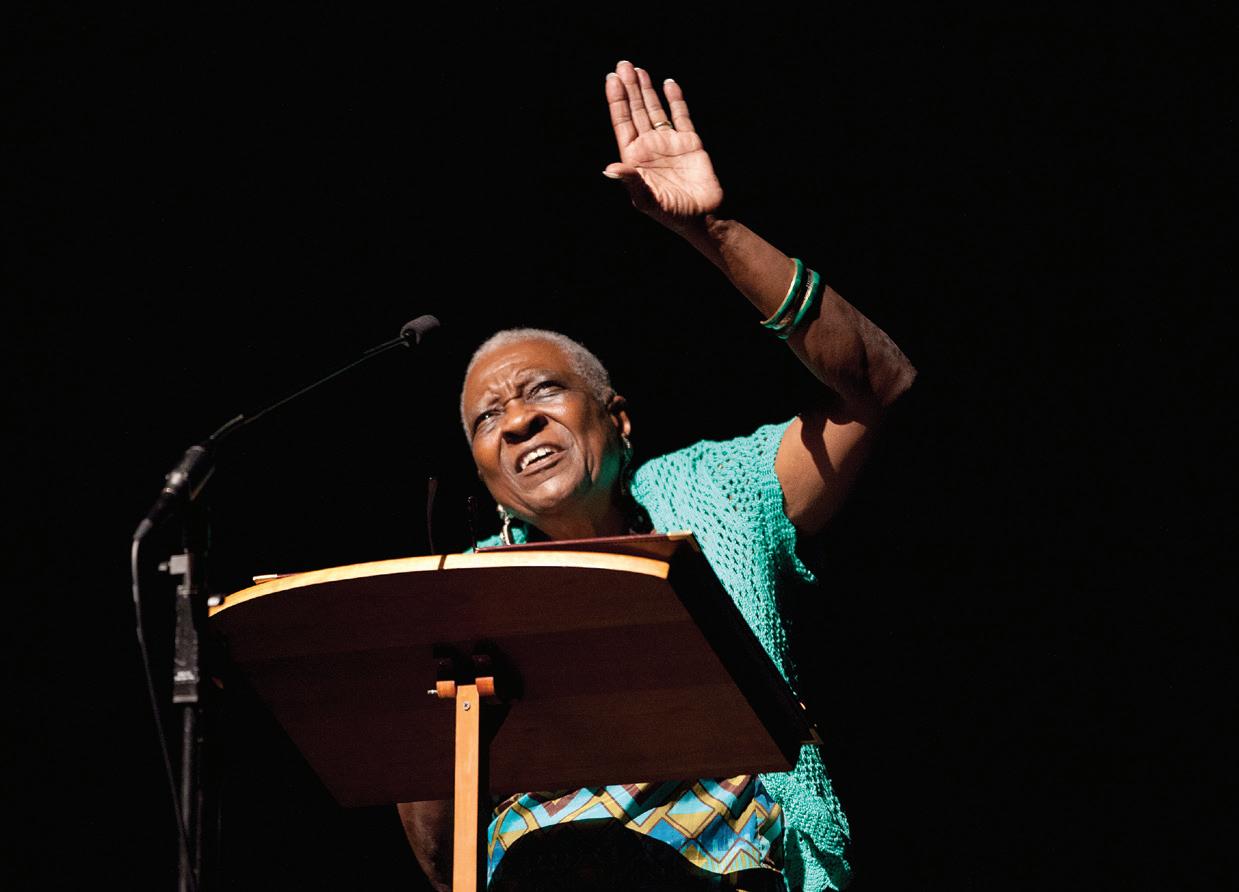
Letter on a letter
I am writing to echo the comments of Tim Werner regarding the importance of Joseph Berman to Ohio University (spring 2023 issue). Dr. Berman served many important and groundbreaking roles at OHIO, not the least was as the founding dean of the School of Communications Systems Management, the first program of its kind at any university. Of course, in its 219-year history, OHIO has both produced and been home to many notable individuals and their historic accomplishments. As an alumna, a former faculty member and Joe’s friend (like countless others), I write in hope that with his passing, Joe’s legacy will be recognized and celebrated.—Kim
Robert Scovill, BSC ’77, MA ’78Full of fun
Thank you for another wonderful issue of Ohio Today. I just love this publication, with its special stories, updates and memories.
The spring 2023 issue was unique for me for three stories of my OHIO connection. The first is the story celebrating Passion Works. Their Passion Flowers grabbed my attention a couple of years ago, and I’m happy to have shared these with friends around the country—and included a bouquet of them on the wall in our kitchen. The second and third were brought home while reading Mapping OHIO Memories. I have no skills whatsoever when it comes to colored pencils, but some volunteer work with kiddos at a local elementary school has motivated me to try. Over the past few months, I’ve been trying to create my own “memory maps,” not knowing there was a name to what I was doing! Tied directly to this: my pursuits as an OHIO aviation program student. A favorite pastime of my solo practice flights was to take
my camera for photos of campus from 1,000 feet up. Maneuvering a plane while shooting pictures was no easy feat! Once again, thanks for the fascinating publication.—Steve Biddle, BSED ’78
We were so excited to get the spring 2023 issue of Ohio Today. It had an especially great profile on Stephanie Howe and her work on the Piketon project with the Voinovich School of Leadership and Public Service. Stephanie is a former colleague of mine at the school whose leadership in Southeast Ohio is phenomenal and needs to be more broadly recognized. Thanks for doing so!
In addition, our 13-year-old (class of 2031?) loved the idea of the beautiful cherry blossom poster inserted into the issue.—Elissa Welch and Jim Welch, MBA ’06
I’m so pleased that you shared the “Last Word? Go Bobcats!” story (spring 2023 issue), and I’m proud of the students who have successfully made their way in the big world and give credit to Ohio University for their success. From what I have gathered, the hands-on teaching experiences have a lot to do with after-college employment and starting up companies of their own.—Myra Andrews Fisher, BSJ ’56, via ohiotoday.org
Dorm distinction
The article about dorm modifications (spring 2023 issue) had a map on pages 22-23 that does not get its point across well. More distinct
colors would have made the buildings much easier to identify, particularly for those of us who have been away from campus for a long time.—J. Thomas Jones, BSCE ’63
Brick by brick
I am honored to have walked, laughed and shared time with Byron Ward. His light was and is still shining bright. He is one of the most positive influences in many of our lives —Richard Shields, BBA ’96, via ohiotoday.org
Camelot
I entered Ohio University in 1959 and graduated with a BSJ degree in 1963. In those days, we lived and studied in “Camelot,” and everyone
eventually knew everyone. When I returned for a class reunion 10 years later, the feeling was there but very faint. We had dinner on the last evening of the reunion, and the wine glasses were all printed with Camelot on the glass. They also had Ohio University printed with our graduation date and the date of the reunion. The University has certainly changed since then.—Suzanne Witkowski, BSJ ’63
WRITE TO US: Ohio Today welcomes comments from readers. We reserve the right to edit for grammar, space, clarity and civility. Send letters by email to ohiotoday@ohio.edu or by mail to Ohio Today, Ohio University, P.O. Box 869, Athens, OH 45701-0869. We regret that we cannot publish all messages received in print or online.

1
Big changes are happening among the university’s leadership, with four new deans named this spring: David Koonce (Graduate College), Patrick Fox (Russ College of Engineering and Technology), Matthew Ando (College of Arts and Sciences) and Tracy Plouck (Voinovich School of Leadership and Public Service).
2
Undergraduates have two new academic honors to strive for: The Dean’s List was joined this spring by the President’s List, presented to undergrads with a minimum of 12 credit hours and a 4.0 GPA, and the Provost’s List, recognizing part-time undergrads with six to 11.99 credit hours and a GPA of 3.5 or more.
3
STUDENT CENTER GETS NEW NAME
The College of Business Career and Student Success Center (CSSC) is now the College of Business Academic Advising and Career Services (BAACS). The new name is a more concise reflection of the work that’s being done in the office, says Dr. Mel Kulp, assistant dean overseeing BAACS.
OHIO unveiled its new National Pan-Hellenic Council Plaza on April 21 with a gathering of University and student leaders, as well as students who make up the multiple National Pan-Hellenic Council (NPHC) organizations on campus. Located near Scripps Amphitheater on College Green, the NPHC Plaza demonstrates the University’s support for historically Black fraternities and sororities, which have had a presence at OHIO for more than a century.



Some newly minted university presidents arrive with a pre-written agenda, ready to make their mark. Others come with a playbook modeled after past successes or a roadmap for a lengthy “listening tour” of sit-down meetings that will fill their calendar for months to come.
But Dr. Lori Stewart Gonzalez, who began her tenure as Ohio University’s 23rd President on July 1, breezed into Cutler Hall that holiday week not with a power suit and a playbook but rather with comfortable (but cute) shoes, a blank notebook and the kind of “Let’s go!” energy that a teenager has as they pass through the gates at Universal Studios for the first time.
Make no mistake, President Gonzalez is far from naïve. With more than 30 years of experience as a faculty member, dean, provost and president at regional and national public universities, she has a stack of tested playbooks taller than the Rip Ride Rocket. What that kind of experience has taught her is that you won’t learn the park by studying the map—you have to walk through the gates and see it.
“There’s just no substitute for investing time meeting with researchers and students in their labs or attending an experiential learning event and seeing the kind of experience our students are getting,”
President Gonzalez says. “There are certain things that are similar across all universities, but we have truly unique research initiatives, experiential learning programs and student leadership opportunities that make OHIO, OHIO, and I won’t be able to effectively move this university forward without digging in and learning about those things.”
With that in mind, beginning with her second week on campus, President Gonzalez dedicated several hours a week to putting miles on those comfy shoes as she made her way around campus and out into the community and the region, simply experiencing OHIO’s work and impact. What’s more, she asked OHIO to share what she was seeing and learning across its social media channels so alumni and prospective students could also get a glimpse into some of the important work happening in research, discovery and outreach.
Her visits ranged from touring high-tech labs, such as the Institute for Sustainable Research and the Environment within the Russ College of Engineering and Technology and the Plant Biology Genomic Facility in the College of Arts and Sciences, to attending a Southern Ohio Copperheads baseball game to see student organizers from the College of Business in action, to visiting the Heritage College of Osteopathic Medicine’s Primary Care Mobile Clinic. She even caught up with Gov. Mike DeWine for a joint visit to the Ohio State Fair.
Ultimately, President Gonzalez’s goal is to discover and understand OHIO’s greatest strengths. She’s less concerned about its weaknesses. And this glass-half-full outlook is the approach she has asked faculty and staff to take as the University defines its next strategic priorities.

“Several years ago, I was introduced to an approach to creating organizational change called ‘appreciative inquiry,’ ” Gonzalez says. “The idea is not to focus on solving problems in the organization, but rather on celebrating successes and building on them to create further success.”
The practice challenges leaders and participants to use positive inquiry to drive positive change. That’s exactly the challenge and charge President Gonzalez presented to four work groups convened this fall to explore strategic goals in the core areas of teaching and learning, research and discovery, outreach and engagement, and people and place.
Their work, she says, is intended to be forward-looking and ambitious—to generate ideas that recognize the University’s strengths and then set the bar ever higher. It’s also intended to be active and iterative. Although President Gonzalez plans to present the results in the summer of 2024, she says she won’t wait to move from idea to action when a great need arises. She also doesn’t want this planning process to be a distraction from continuing the amazing research and programming she has been introduced to over the last several months.
“I want to make sure we continue investing in our distinctive research and programs,” Gonzalez says. “OHIO has tremendous momentum, and it’s important to me that we don’t see this presidential transition as a time to take a pause. We need to keep moving forward and build on this moment.”
In other words, slip on those comfy shoes, Bobcats, and let’s go! —Robin Oliver, Vice President for University Communications and Marketing
1. She is the first woman to serve as President of Ohio University.
2. She was born and raised in the small Appalachian Kentucky town of Mt. Vernon.
3. Her family owned a feed store serving farmers in Rockcastle County.
4. Her father attended Berea College and impressed on his children the power of education and the responsibility they had to use their education to serve communities.
5. All three of Dr. Gonzalez’s siblings, two sisters and a brother, hold advanced degrees.
6. She earned an undergraduate degree from University of Kentucky, her masters from Eastern Kentucky University and a Doctor of Philosophy in Communication Sciences and Disorders from the University of Florida.
7. Before moving to Florida to earn her doctoral degree, she practiced as a speech-language pathologist in her Appalachian hometown.
8. Dr. Gonzalez sees communication as foundational to human connection and viewed her clinical work as helping people create and sustain connection.
9. She has held faculty appointments at Southern Illinois University, University of Kentucky, Appalachian State University, University of Tennessee Health Sciences Center and University of Louisville.
10. Before moving into administration, Dr. Gonzalez served as Faculty Council Chair at the University of Kentucky.
11. After transitioning to leadership, she was Associate Dean and then Dean of the University of Kentucky College of Health Sciences for 11 years.
12. Her only son, Clay, lives in Michigan and works as a music composer and conductor.
13. As Dean, Dr. Gonzalez helped to increase research success in the UK College of Health Sciences, moving the National Institute of Health ranking from 44th to 12th over five years.
14. During her time as Provost at Appalachian State University, she helped lead the development of a transformative strategic plan that made sustainability a campus imperative.
15. While serving as Interim President at the University of Louisville in 2022, Dr. Gonzalez helped secure the largest gift in the University’s history—$47 million for a new vision for the health campus.
16. While she is always looking for green items to add to her wardrobe, she loves wearing black.
17. She’s been married to her husband, Randy Gonzalez, for more than 30 years.
18. She prefers dogs over cats.
19. She and Randy have collected art pieces from local artists in each area where they have lived. They are already the owners of an original Athens block.
20. While in Louisville, Dr. Gonzalez served as a Board Member of the city’s Fund for the Arts.
21. She loves football and will host a Presidential tailgate at every OHIO home game this season. She also became a huge baseball fan during her time in Louisville.

22. As the mother of a young musician during Clay’s high school years, she served for two years as co-President of the Lafayette Band Association in Lexington, Ky.
23. In her letter of interest for the position of President, she wrote this about the way she approaches her career: “I believe that when we serve in public education, we have an obligation to honor the public’s investment with hard work, honesty and a commitment to serve the public good.”
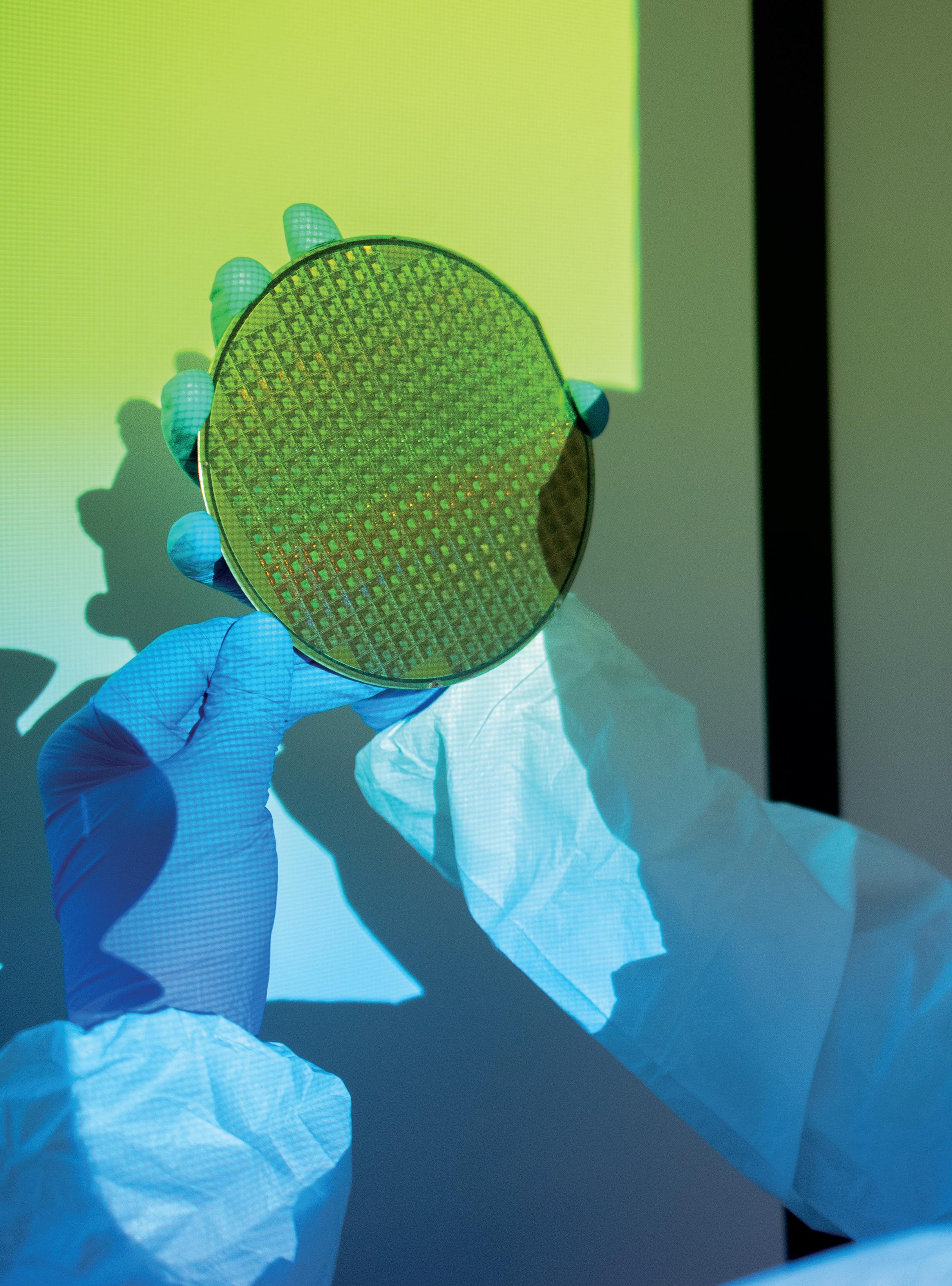
Last September, Intel awarded OHIO a $3 million grant to serve as the lead institution for the Appalachian Semiconductor Education and Technical (ASCENT) Ecosystem, which brings together multiple universities and community colleges to support workforce development and training for the growing high-tech manufacturing industry in the region. In April, seven Ohio University Lancaster students became the first to receive scholarships funded by the grant. ASCENT leaders at OHIO plan to continue identifying opportunities for scholarships, and the University will launch new certificate programs in automation and mechatronics this fall (see page 20 for details on those programs). Photos by Dylan Wayne Townsend,


The annual Nelsonville Music Festival is widely known for presenting some of the best established and up-andcoming artists from a wide range of genres. But the NMF, as it’s known, also provides a hands-on educational opportunity for OHIO media students.
Led by Scripps College’s Josh Antonuccio, students work with staff from NMF and WOUB to produce the festival, learning skills such as recording artists’ sets for audio and video, running stage management and overseeing artist relations.

Green Scenes

The OHIO marching band isn’t the only campus mainstay celebrating its centennial this year. (See more about the band on page 34.) The University’s esteemed journalism program also got its start 100 years ago, when English professor Raymond Slutz offered the first OHIO journalism course. Here’s a look at how things evolved from that single course into the E.W. Scripps School of Journalism we know today.
In 1924, the Department of Journalism, led by Director George Starr Lasher, was established within the College of Liberal Arts. The year after that saw the start of experiential learning in the program, with students writing and editing copy for The Athens Messenger
The program became the School of Journalism in 1936, and in 1947 a public relations sequence was added to the existing offerings (newswriting and editing, feature and magazine writing, newspaper advertising, business management, pictorial journalism, and radio journalism, which became radio-TV journalism in 1954). WOUI-FM, the precursor to WOUB, became the third FM college station in America shortly after, in 1949.
In the late 1960s, the College of Communication was established to house the School of Journalism and other programs. Its first dean, John Wilhelm, was a former World War II correspondent and one of the first reporters to cover D-Day.
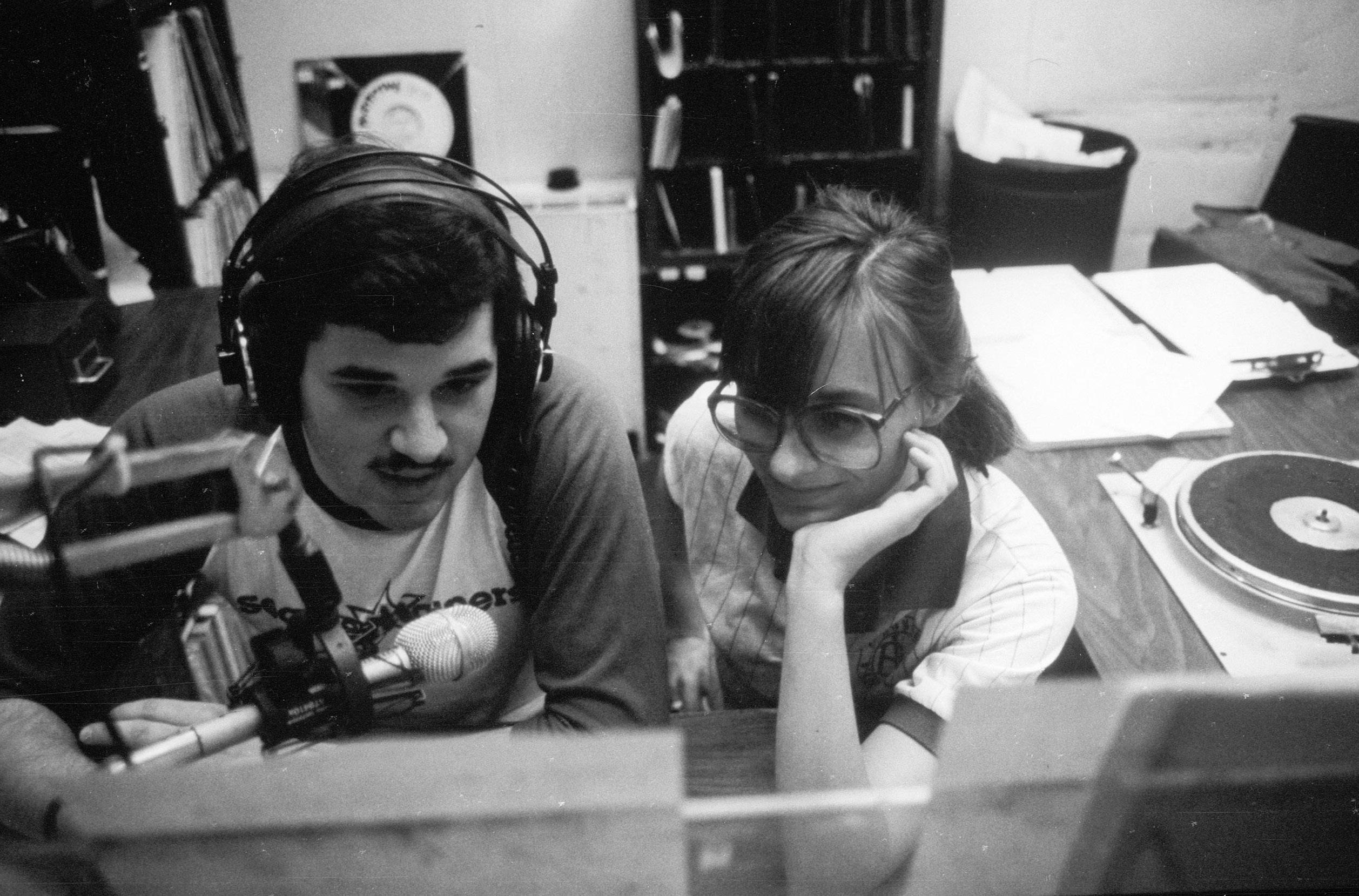
The Scripps Howard Foundation began supporting the School of Journalism around the same time, but that relationship changed in 1982 with a $1.5 million endowment from the foundation that prompted renaming the school to the E.W. Scripps School of Journalism. The following year, the Associated Press Managing Editors Association named the school as one of 10 outstanding journalism programs in the country.
After sharing the Radio-Television Building with the School of Radio-Television since 1970, Scripps landed in its own building—the newly renovated building previously known as Carnegie Hall—on College Green in 1986. Nearly 30 years later, the Scripps College of Communication began moving into its current home in the Schoonover Center for Communication, on the site of the former Baker University Center, completing the transition in 2015.
Since its inception, alumni of OHIO’s journalism program have earned more than two dozen Pulitzer
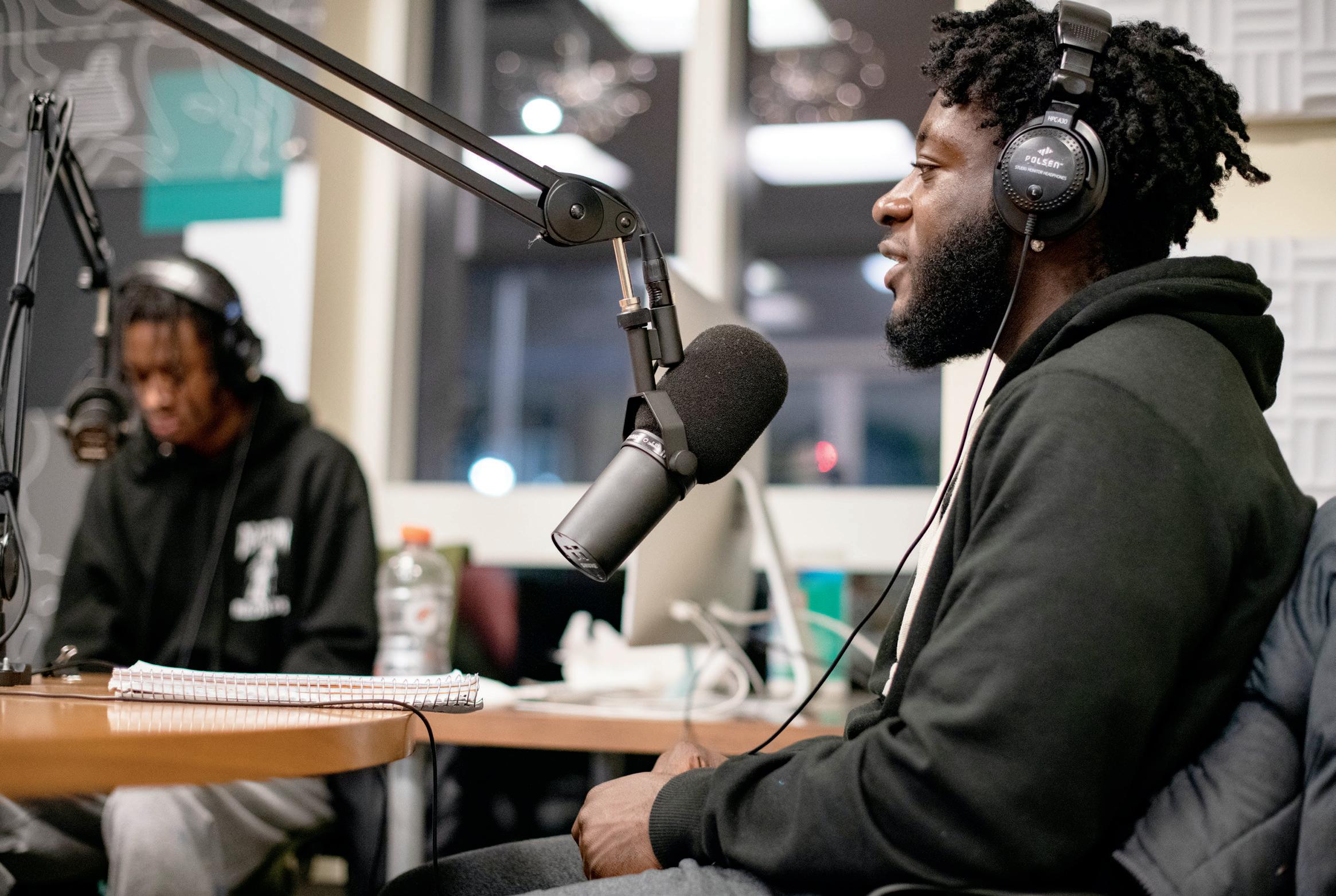
Prizes, and five have won the College Photographer of the Year award since 1978.
Several events this spring and summer have honored the school’s milestone, and more opportunities to celebrate are forthcoming this fall.
Don’t miss the Journalism Centennial Homecoming Celebration at Alden Library (Oct. 6, 4 p.m.), which will feature guest speakers and exhibits that detail the historic reporting produced by OHIO alumni. And on Nov. 2, the library will open its exhibit titled “A Celebration of the Impact on Journalism by the E.W. Scripps Company.” The date coincides with the 145th anniversary of the founding of Cleveland’s Penny Press newspaper—the beginning of the E.W. Scripps Co.— by Edward Willis “E.W.” Scripps and his sister, Ellen Browning Scripps. —Emma Henterly, BSJ ’10
For more information, visit ohio.edu/scrippscollege/journalism/100-year-anniversary.
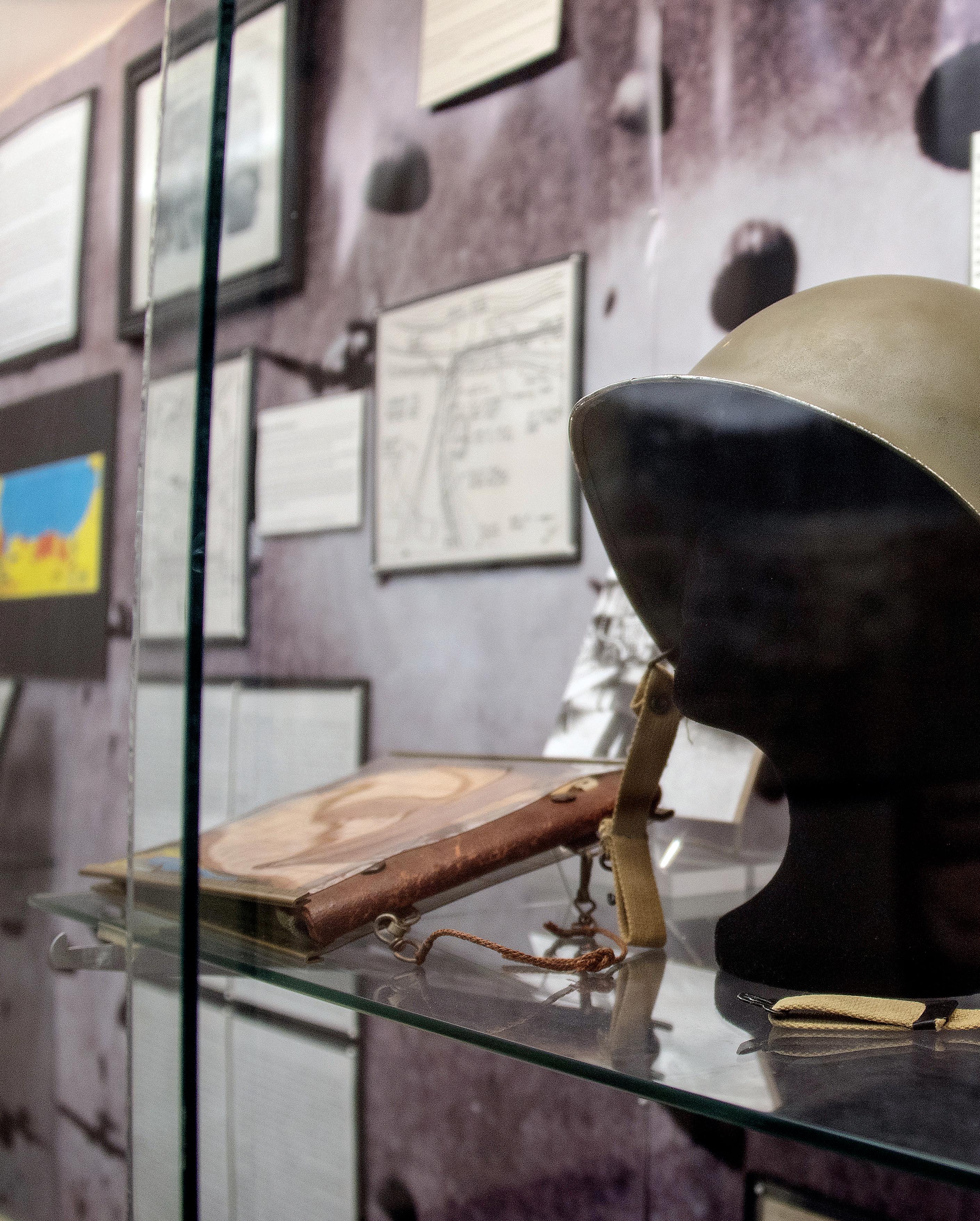
The Cornelius Ryan Room on Alden Library’s fifth floor has a new look. In addition to pieces from the famed World War II reporter and author, the room now brings visitors “into the intimate thoughts and experiences of those who were directly involved in the events” of WWII, according to senior Alex Hines, who co-curated the exhibit with manuscripts archivist Greta Suiter. Visit it weekdays from 9 a.m. to noon and 1 to 4 p.m. during the academic year.


OHIO has three new certificate programs offering a variety of hands-on experiences.

The first two programs, Automation Technician and Mechatronics Technician, make their OHIO debut at the Lancaster campus this academic year. Each is a five-course sequence designed to be completed in one year so students can help meet the demand for skilled manufacturing technicians as Intel and other high-tech manufacturers continue moving into central Ohio. These certificates support the goals of the Appalachian Semiconductor Education and Technical (ASCENT) Ecosystem, an initiative aimed at creating an inclusive workforce development and training program to support Ohio’s growing advanced manufacturing and semiconductor industry.
The third, a revival of the Jewish Studies Certificate in the Classics and Religious Studies Department, was introduced in fall 2022 and examines Jewish history and culture. Last spring, the certificate program included a Global Jewish Foodways course featuring hands-on learning in the kitchen; this spring, there will be a course on the history of Jewish humor. Both are taught by Sarah Livingston, executive director of Hillel at OHIO. The program also includes a revived Introduction to Jewish Studies course, offered in fall 2022 and 2023.
Students work with robotic equipment at the Fairfield Workforce Development Center at OHIO Lancaster.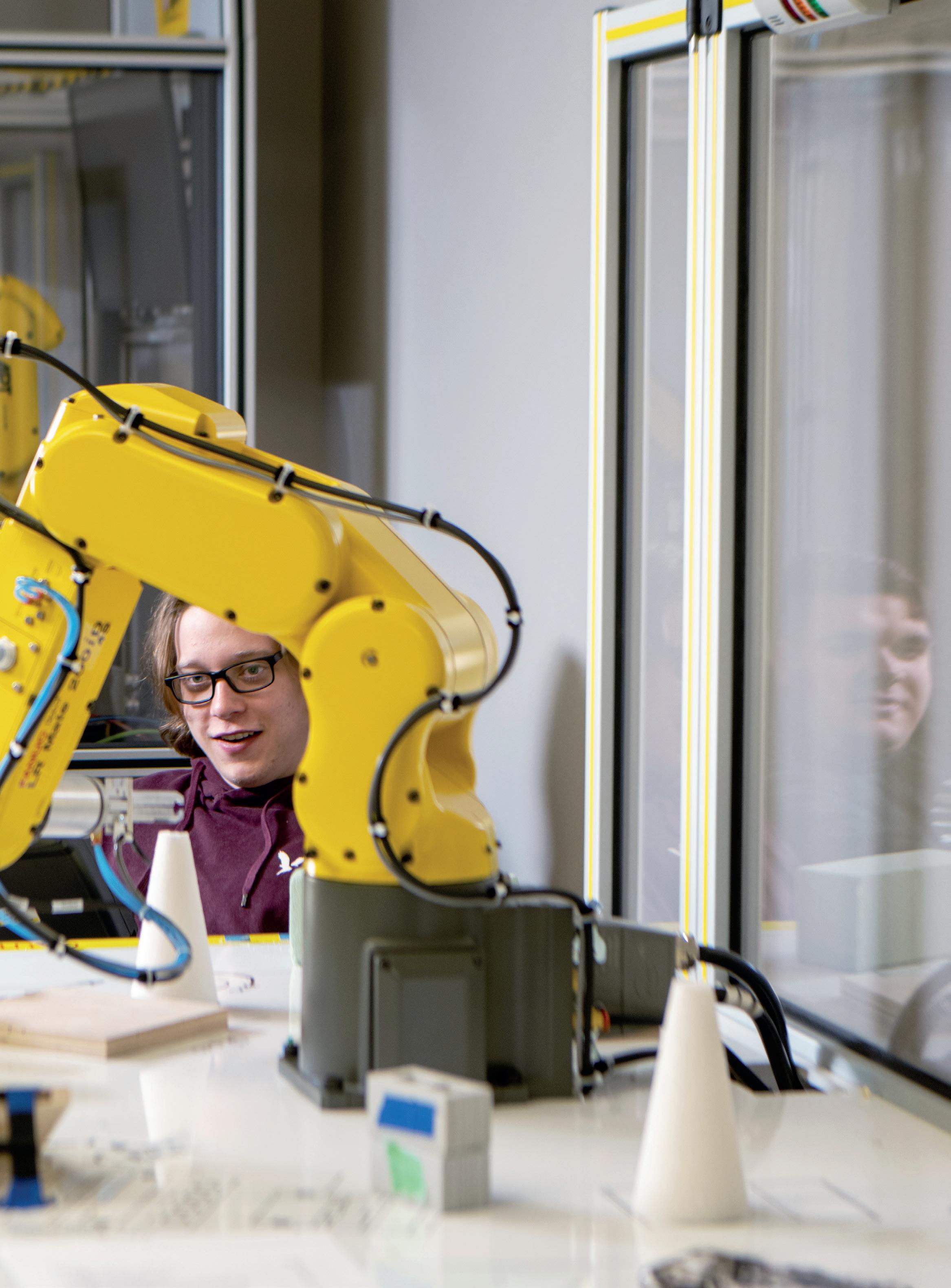
Bobcats make the news—and the OHIO community proud—every day. Read about a few of the Ohio University alumni, students, faculty and staff who have made headlines in recent months.
The New York Times, New York Post and others reported that the Pathfinder-class oceanographic survey ship formerly named USNS Maury has been renamed the USNS Marie Tharp as part of an effort to oust references to Confederate names on federal property. The new name honors OHIO alumna Tharp, who graduated from the College of Arts and Sciences in 1943 with bachelor’s degrees in English and music. However, a geology class at the University set her on her path to change geography as it was then known, says geographer, President Emeritus and Trustee Professor M. Duane Nellis. Tharp became a pioneering geologist and oceanographic cartographer who created the first scientific maps of the Atlantic Ocean floor and provided the first understanding of plate tectonics and continental drift. Photo courtesty of

images
A team of scientists led by OHIO physics professor and Argonne National Laboratory scientist Dr. Saw Wai Hla have taken the world’s first X-ray SIGNAL (or SIGNATURE) of a single atom. This groundbreaking achievement was funded by the U.S. Department of Energy’s Office of Basic Energy Sciences, and it could revolutionize the way scientists detect and identify materials in a sample. Scientific journal Nature featured the accomplishment on the cover of its June print edition; hundreds of news outlets around the world have also covered it. “The technique used, and concept proven in, this study broke new ground in X-ray science and nanoscale studies,” says Tolulope Michael Ajayi, MS ’18, PHD ’22, who is the first author of the paper and is doing this work as part of his Ph.D. thesis.
Magazine, the official publication for New York City’s Museum of Modern Art, highlighted Professor Emeritus Daniel S. Williams for his photograph, “Untitled (Juneteenth Emancipation Day celebration),” taken in 1982 and acquired for MoMa’s collection the following year. Williams spent three decades photographing Juneteenth and Emancipation Day celebrations across the country, immersing himself “in parades, sermons, and communal cookouts, photographing candid moments of celebration,” according to the article. “From bustling urban centers to rural towns, Williams captured how communities came together to honor the struggles and triumphs of their ancestors. Through his lens, we are transported to rituals of remembrance and rejoicing.” The story included several photos from Williams’ Juneteenth project and an interview with Williams and his daughter, Megan Paulson.
OHIO was included in a list of environmentally friendly colleges in The Washington Post, thanks to the extensive compost program at Culinary Services. The program, which the Post described as “one of the most efficient university food services in the country,” collects more than 600 tons of food waste annually for processing at the University’s composting facility. Located on The Ridges Green, the facility opened in 2009 and expanded in 2012. It’s the largest known in-vessel composting system at any university nationwide; after spending about two weeks in the vessel, compost is placed in rows outside the facility for three to four months before being used for landscaping, athletic fields and more. Solar panels on the roof provide about 75 percent of the facility’s energy.


Dr. Andrew Yuan’s approach to caring for his patients is informed by his personal experience with a physical disability and his OHIO education. Learn more about his background and philosophy on patient care in a video with him at ohiotoday.org.
Photos by Ben Wirtz Siegel, BSVC ’02
Over his 20-year career, Dr. Andrew Yuan, DO ’87, a prominent physiatrist in Fairfield, Connecticut, has concentrated on healing both the physical and emotional needs of his patients. A graduate of Ohio University’s Heritage College of Osteopathic Medicine, Yuan has overcome immense personal challenges and transformed countless lives.

Born and raised in Hong Kong, where his family had emigrated from China, Yuan arrived in the United States at 10 years old, when his father’s career in textiles sent the family throughout North America. His mother propelled his dream of being in medicine, he says, but that dream was brought to the brink of extinction when Yuan suffered a life-altering accident in which he lost an arm and a leg.
“Any losses—including loss of culture, loss of family, as well as loss of physical capability—alter your perception, your confidence, as well as create a lack of resilience,” Yuan says. “You don’t know if you can climb from the pit we call the abyss. Thank God I was young. I never gave up my dreams. I had to reprogram, relearn and retrofit everything.
“But it’s given me the opportunity to realize that being different … as well as being somewhat challenged, is always good,” he reflects. “It keeps me on my toes and allows me to embrace the challenge with confidence, at the same time having a humble understanding that if it doesn’t turn out, it’s OK. Nobody has done this before.”
Yuan views his physical challenges as a sort of alchemy for his pursuit of a career in physiatry. “When I got into medical school, I was elated,” he says. “My treating physician who helped me overcome my
disability was an orthopedist in rehabilitation. He said, ‘Andy, if you can get into medical school, I will take you out of the match and you will be our resident.’ It was a gift.”
Yuan’s approach to treating patients as a physiatrist goes beyond addressing physical symptoms. Given his osteopathic education, his chief focus is on a person’s overall well-being, understanding that each patient’s journey is unique. “The first thing I say to a patient in the hospital when the patient has had [an amputation is], ‘My job is not to replace your limb. My job is to protect the limb that you have so you don’t further damage it.’ ”
While he acknowledges this idea is fundamental to osteopathic physiatry, Yuan notes such simplicity can be overlooked in the rush for more technologically advanced solutions to patient’s problems. “Patients want the newest technology in an artificial leg, but they [also need to] know how to walk with the other leg,” he says.
Yuan combats this technological disconnection in medicine during his time with patients, noting people seem increasingly hungry for a one-to-one connection. “Ninety to 95 percent of patients who come to see me know that I don’t use a computer,” he says. “They seek me out. They say, ‘You’re the first doctor who actually listened to my problem.’ ”
He credits his experience at OHIO with providing the basis for his heartfelt and insightful medical practice. “It feels like home,” he says of the University. “For a person who’s been different, who is looking for homes, this profession, this town has given me a home. That’s left an indelible memory for me.” —Sarah Filipiak, BSJ ’01, BS ’23
The Ohio University Innovation Center has been incubating startups since 1983

Growing plants requires water, sunlight and nutrients. The formula for growing startup businesses is a bit more complicated and individualized, but there are some common needs: office space, state-of-the-art equipment and professional coaching, to name a few. Since its founding in 1983, the OHIO Innovation Center has provided these and more resources to over 300 businesses, generating a combined $66.6 million in economic output— not in its 40-year history, but in 2022 alone.
Like an incubator that keeps baby chicks warm and secure, the Center is a “safe space” for budding tech businesses during their challenging first years, says Director Stacy Strauss. According to the U.S. Small Business Administration, about 50% of new businesses fail within the first five years. That figure goes down to 15% among businesses that engage with an incubator like the Innovation Center, Strauss says.

Businesses that successfully outgrow the Innovation Center are wins not just for the Center, but Southeast Ohio as a whole. That’s exactly what Wilfred Konneker envisioned when he helped establish the Center to draw high-tech industries like biotechnology, telecommunications and robotics to the region.
In the future, Strauss wants to extend the Center’s services to more mature businesses as the region and state continue to grow. The Athens County Port Authority Board last year broke ground on a 60,000-square-foot building in The Plains, which Strauss believes will provide much-needed retail space for companies ready to strike out on their own.
Intel’s landmark investment of $20 billion in the state will also bring new opportunities. “There’s going to be a big, big push for Ohio continuing to be the home for a lot of tech, and that should really trickle down to the Innovation Center as well,” Strauss says.
Ohio Today spoke with three entrepreneurs about how the Innovation Center helped support their businesses; read on to see what they had to say.
After establishing Third Sun Solar in 2000, Michelle Greenfield, MA ’94, and her husband, Geoff, MA ’94, ran the solar power business out of their home for three years, which made it nearly impossible to expand. “We didn’t have the cash flow or the confidence to just start renting our own place,” Michelle says. “We were actually exploring leaving Athens.”
Within months of renting a small office in the Center in 2004, the Greenfields hired one employee, then two more. Eight years later, Third Sun Solar “had kind of taken over the first-floor wing” of the Center, Michelle says, and employed about 30 people, including several alumni of OHIO and the nearby Hocking College.
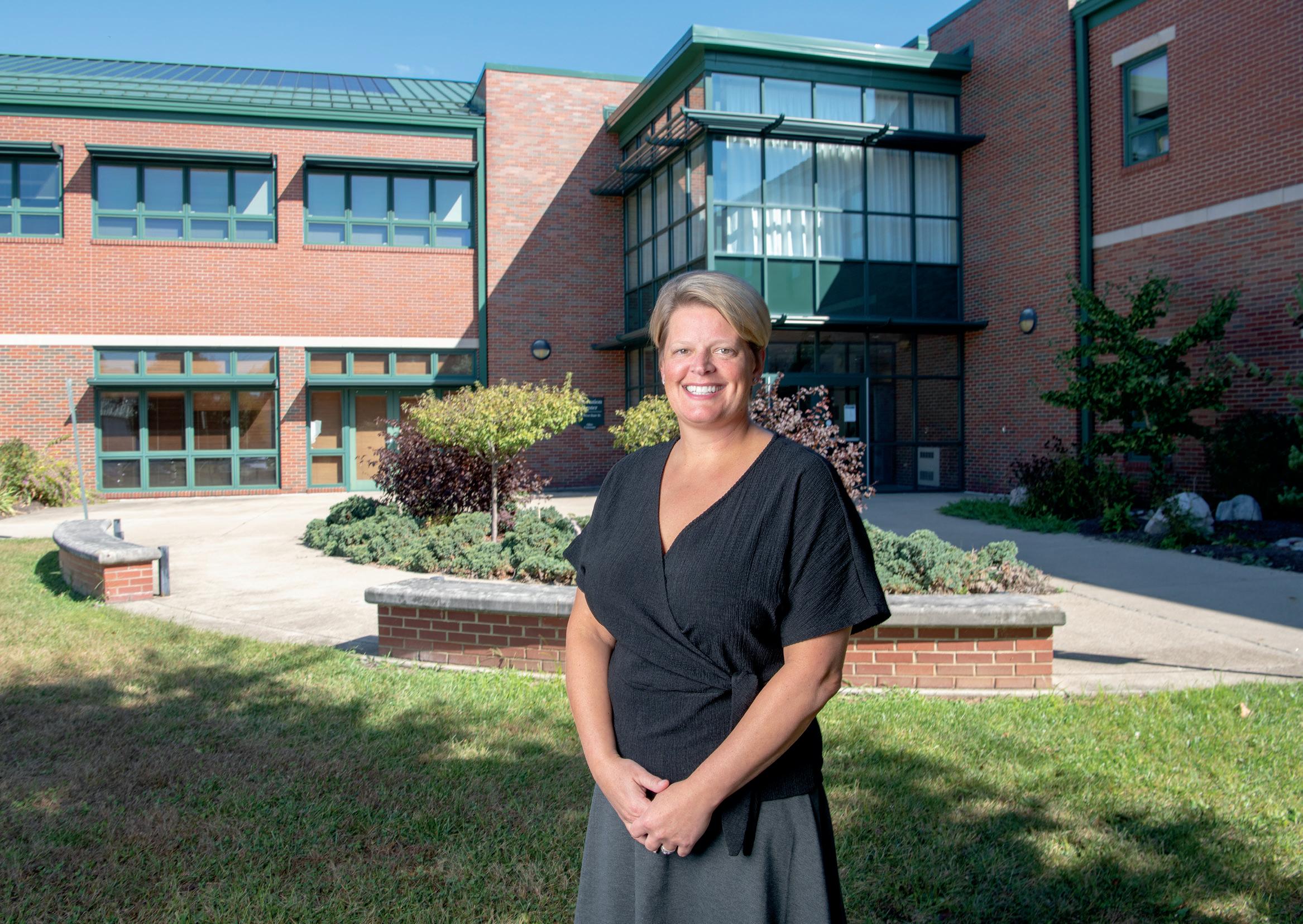
Without the Center, that growth “would’ve looked really different,” she notes. “It would’ve either been slower growth, or maybe moving out of the city or out of the county and growing somewhere else. So it was just a really good fit for us at the time that we needed it.”
Third Sun Solar rented office and warehouse space from the Center until 2012, when the Greenfields moved into their own building on West Union Street. In 2022, the company was acquired by Kokosing, and Geoff became director of solar strategy for Third Sun Kokosing Solar.
“In the early 2000s, solar was not very prevalent,” Michelle says. Today, “the industry is maturing. There are large, national players now.”
It’s no secret that academia is a rich breeding ground for innovation, but how can faculty turn their ideas and technology breakthroughs into marketable products? That’s the problem Shiyong Wu set out to solve with ASAKE Biotechnologies.
“They cannot get money to put them into the market,” says Wu, an OHIO professor of chemistry and biochemistry who also leads OHIO’s Edison Biotechnology Institute.
Most U.S. government funding for such endeavors, referred to as translational research, is reserved for for-profit businesses, “so for faculty to get this money, they have to start a company,” Wu says. “But most faculty, they’re so busy. ... And often, they don’t know the rules.”
So, in addition to conducting their own therapeutics research, Wu and his ASAKE cofounders submit grant proposals in collaboration with OHIO faculty for their translational research projects—tasks he says would be impossible if ASAKE operated independently.
“Without the Innovation Center, I cannot have this company,” he notes. “The lab space and specialty
equipment, that’s very important. For a new startup, it’s very hard to buy things. We have no money to buy new capital equipment, but [the Center has] all the necessary capital, equipment and the storage.”
These resources have already proved their worth: Earlier this year, ASAKE received a $2 million grant from the National Institutes of Health to fund ongoing research into a novel compound that could potentially reverse the progression of Type 1 diabetes.
When JD Kittle, BS ’80, left his career in biotechnology in 2011 to become an OHIO assistant professor of chemistry, he was also on the lookout for his next entrepreneurial endeavor. With the Center’s help, he co-founded Molecular Technologies Laboratories in 2012 to provide contract research services to clients.
“Having a place to do meetings, having the resources in the laboratories and equipment” gave MTL an air of professionalism, Kittle says. And the Center’s professional coaching services allow startups to “put a 360-degree plan around what you’re doing: marketing, sales, product development, manufacturing finance.”
One of MTL’s research projects led Kittle to his current role: chief science officer of CytoSPAR, a startup developing a new method of testing bacterial resistance to antibodies. CytoSPAR is a client of InfinixBio, which was formed in 2019 by the merger of MTL with another biotech company. InfinixBio is still based at the Center and has another location in Columbus.
Kittle says his experience is just one example of how the Center has nurtured the growing biotech industry in Southeast Ohio. “Before, biotech was restricted to a few key areas,” he says. “[Now,] the power of biotech is being experienced by different communities across the country. And I’m glad that Athens is able not only to partake but play an important role in what is the reindustrialization of the United States.” —Cat Hofacker, BSJ ’18


The Marching 110 has a storied history at OHIO, but its origins go back further than most realize. This year marks the 100th birthday of the University’s marching band.


“Ladieeeees aaaand gentlemennnn, under the direction of Dr. Richard Suk, we proudly present the most exciting baaaand in the laaaand: the Ohio University Marching 110!”
The crowd starts to cheer. It almost feels like you’re climbing the first, steep hill of a roller coaster with nearly 200 of your closest friends, people who have become more like family. You’ve all put in the time and the sweat to prepare for this moment, but that doesn’t make it any less nerve-wracking—or any less thrilling.
You’re carrying on traditions more than five decades old: the white and black uniform with a green-outlined “OHIO” emblazoned diagonally across the front; the crisp steps, thighs parallel to the ground and calves extended 45 degrees; the triumphant, John Higgins-arranged fanfare, “Stand Up and Cheer.”
You’re connected to a history of excellence that extends back even further. It’s a thread that links current students to the first band members to wear those uniforms in 1967, to the beginning of the style of band that thrills audiences today. And in a more circuitous way, that thread connects to Homer T. Baird, GEN ’26, who started the first marching band at Ohio University in 1923.
“We pay homage to our past,” says Dr. Richard Suk. “There’s a small number of bands that have kept their uniforms that they used 50 years ago.”
“The band being so steeped in tradition in so many different ways is what makes it a special organization,” adds Josh Boyer, BMUS ’08, MM ’14, a former assistant band director and the field commander in 2007.
This year, Ohio University celebrates its 100-year history of marching bands and the traditions that have shaped The Most Exciting Band in the Land.
Homer Thomas Baird, of Nelsonville, started the first official marching band at Ohio University in 1923 with just over 40 members. Then-University President Dr. Elmer Bryan approved the new band under two conditions: the School of Music signed off and it cost the University no money.
Of that early band, Baird once said, “Twenty-five were top-notch musicians, and the others were coming along fine.”
Raymond Wyatt Connett, BSED ’31, directed that band from 1923 to 1925. The director of the School of Music, Dr. C.C. Robinson, gave his blessing to the new band and offered Connett a small sum of $10 per rehearsal, according to “Diamond Ohio: A History of the Ohio University Bands” by George Brozak, BMUS ’90, MMUS ’92, a former marching band member, graduate assistant and arranger.
1923-1925: Raymond Connett, BSED ’31
1923: Student Homer Thomas Baird, GEN ’26, holds the first meeting to create an OHIO marching band.
1923: Homer Baird is elected the first band president.
1926-1928: John Hollingsworth Gill
1926: The band makes its first appearance in the Homecoming parade.
1929-1945 : Curtis William Janssen
1931: Kappa Kappa Psi, a national honorary band fraternity, starts at OHIO.
1939: The band plays in Columbus at the inauguration ceremony of Gov. John W. Bricker
1943: Ohio University halts football— and therefore, the marching band— during World War II.
1945: Football returns to Peden Stadium. A 110-member marching band— including female members—performs.
1946-1947: Daniel Martino
1948-1950: Charles Everett Gilbert
1949: The band produces its first album, The Songs of Ohio University. Members sign the first copy for Homer Baird.

1951-1966: Charles Minelli
1951: Director Charles Minelli establishes the first Varsity Show and Band Day.

After early, rapid-fire changes, the marching band began to find its style. The “Ivy League” look of the early 1960s was requested by then-President John Calhoun Baker. In 1967, director Gene Thrailkill conceptualized the uniform style still used today.


The first uniforms were navy blue and white with long jackets and capes, though the band’s look would change multiple times over the years. (See our illustration of past uniforms on page 33.)
Both football and marching band were put on hold for two years during World War II. Strapped for musicians during that time, OHIO’s concert band included women for the first time in January 1943; when the marching band stepped back onto the field in 1945, women joined them (though female-only bands had been formed under directors Curtis Janssen, 1929-1945, and Charles Gilbert, 1948-1950).
By the 1940s, Ohio University had a marching band, varsity band, symphonic band and three pep bands. Six directors would oversee the marching band before its most transformational one took the baton: Gene “Coach” Thrailkill, MED ’62.

Thrailkill, of Illinois, had a clear vision for the marching band when he took the reins from director Charles Minelli in 1967: new uniforms, new songs featuring the day’s top hits, a new marching technique—and no women.
“What I wanted to do, No. 1, was make the band enjoyable for the band members, and No. 2, I wanted to appeal to the student body,” Thrailkill said of the controversial decision in a 2013 WOUB documentary. Thrailkill died in 2021.
Thrailkill modeled the new “100 Marching Men of Ohio” (renamed the following year as the “110 Marching Men of Ohio”) off his alma mater, the University of Michigan’s Marching Men of Michigan. The Post was critical of the change, and several students bemoaned the loss of the majorettes.
“[Thrailkill] had a vision,” says David Fowler, BMUS ’72, a feature twirler in 1967 and the band’s final drum major from 1968 to 1970. “He knew what he wanted to see if he was sitting in the stands and what he wanted to hear: that wall of sound.”
The future of Thrailkill’s experiment would hang on the first note of the newly arranged “Stand Up and Cheer.”
“[When] we went out there for that first show in 1967, we were scared to death,” Fowler says. “But we had the new uniforms and all that, the new style and everybody up in the stands was like, ‘Woo, what is this?’ By the time we finished, we got a standing ovation, and the rest is history.”
That era would birth nearly all of the band’s traditions, from its dances to its instrumentation. Fowler helped craft some of those first dances, including a 1968 routine to “Ain’t Been Good” that is still performed after
1951: Homer Baird is elected Honorary President of the Ohio University Bands for life.
1951: Tau Beta Sigma, the national honorary band sorority, starts at OHIO.
1956: Phillip Eugene Saunders, BFA ’59, is the first Black drum major.
1967-1970: Gene Thrailkill, MED ’62
1967: Gene Thrailkill makes the band male-only. He also arranges the University’s fight song and institutes the uniforms, sound and high-energy style that students know today. He names the band the “100 Marching Men of Ohio.”
1968: The band becomes the “110 Marching Men of Ohio.”
1968: A John Higgins arrangement of blues song “Ain’t Been Good” becomes one of the band’s first dance numbers. It is still performed after football games today. The band also adds a fanfare to “Stand Up and Cheer” and a new introduction to “Alma Mater, Ohio.”
1971-1972: Thomas Lee
1973-1989: Ronald P. Socciarelli
1973: “Long Train Runnin’,” featuring the tuba section, and “Cheer,” featuring the trombone and trumpet sections, are added to the band’s dance numbers.
1974: The marching band begins an annual tradition of performing at the Ohio Theatre in Columbus.
1975: Women return to the band again under director Ronald P. Socciarelli, and the band becomes the Marching 110.
1976: The Marching 110 becomes the first marching band in history to perform at Carnegie Hall.
1980: A Geoffrey Horn arrangement of the Styx song “Light Up” is added, featuring the cymbals section.
1990-1995: Sylvester Young
1993: The Marching 110 represents the state in President Bill Clinton’s inaugural parade and plays a concert for the presidential inaugural ball.
1996-present: Dr. Richard Suk
2000: Director Richard Suk institutes the student arrangers’ contest; the band performs the winner’s song.
2000: The Marching 110 is the only Ohio band selected to perform at the Macy’s Thanksgiving Day Parade.
2001: The marching band participates in an emotional performance for the New York Giants’ first game after the Sept. 11 tragedy.
2005: The Marching 110 performs in the Macy’s Thanksgiving Day Parade as the lead band.
2006: 15 band members perform as surprise guests on NBC’s Deal or No Deal.
2010: The Marching 110 participates in the 121st Tournament of Roses Parade in Pasadena, California.
2013: The marching band performs in Dublin, Ireland, and at St. Peter’s Square in Vatican City, Italy.
2019: Sophia Medvid becomes the first female field commander of the Marching 110.
2023: The Ohio University marching band celebrates its 100-year history.

The band’s best-known drum cadence is “Funk,” which is played during parades and as the band leaves Peden Stadium. It features turns and high kicks. Alumni band members are told “you’re never too old to funk.” Visit ohiotoday.org to learn more Marching 110 insider phrases.

home football games today. As for the instrumentation: No men were interested in playing flute or piccolo in the late 1960s, so the band instead performed with clarinets, saxophones, brass and drums.
“The dancers just absolutely took people by storm,” says former mellophone player Tom McKee, BSJ ’73. He recalls performing Frankie Valli’s “Can’t Take My Eyes Off You” with a basic dance step that still turned heads.
“We took that show to Miami, and we got a standing ovation from the Miami crowd … I have never heard such a loud ovation in my life,” McKee says. Shortly after, Thrailkill got a letter from Miami University’s president, McKee recalls, saying “something along the lines of ‘I’m never going to be embarrassed like that again.’ ”
The Marching Men of Ohio lasted eight years. In 1975, Director Ronald P. Socciarelli readmitted women to the marching band in the wake of Title IX. With the addition of women, the name changed from the 110 Marching Men of Ohio to the Marching 110.
No longer referring to the size of the band, its namesake 110 took on new meaning, referring to the 110% effort given by each member at each performance. The following year, the 110 became the first marching band ever to perform at Carnegie Hall.
Perhaps nothing sets apart a marching band member on Athens’ campus quite like the green jacket with the white patch of Ohio. Students practically live in them. Alumni try to fit back into them. They unite band members across directors and decades.

“It’s something that is internal to us, because it’s like a symbol of membership,” says Boyer, the former field commander and assistant director. “But it’s external in that everybody sees that jacket and understands [the wearer is] a member of the Ohio University Marching Band.”
The jacket is a symbol and a reminder that each band member is a part of something bigger than themselves on campus. “It was just an absolute thing of pride to put that jacket on,” McKee says.
Two years ago, band members started a new tradition of presenting the green jackets during a formal ceremony that includes the reading of a poem written by McKee.
“Everyone wants to have one, because when you see the band jacket, everyone else knows you’re affiliated with one of the greatest organizations on campus,” says Eric Steere, a senior trumpet player

Every homecoming, about 400 members of the most exciting alumni band in the land march down Athens’ brick streets to thrill the crowds, one more time.
The tradition of former 110 members assembling for Homecoming started in 1973 and has continued, largely uninterrupted, ever since. The alumni group became an official organization in 1999, 26 years after that first performance, when OHIO’s Alumni Association Board of Directors approved the official Ohio University Marching Band Society of Alumni and Friends. In fall 2020, the organization was renamed as the Marching 110 Alumni Network.
Homecoming—known among band members as “Christmas,” because it’s the most wonderful time of the year—is a time for alumni to reconnect with one another, meet the current students and relive their status as campus rock stars.
“It’s an energy that you can’t replicate anywhere else in your life,” says Mike “Ica” Eubanks, who played snare drum from 1996 to 2001 and is the president of the Marching 110 Alumni Network. (Eubanks, BTAS ’21, MED ’23, left OHIO in 2001 and later returned to complete his degrees.) “It’s that one day where you get to do that again for a couple of hours,” he explains. “Man, it’s worth it, to be sore on Sunday.”
The Marching 110 Alumni Network also holds an annual fundraiser in Columbus called “Halfway Home.” The group contributes financially to the band, purchasing senior mugs and helping to defray the cost of gloves, practice uniforms and items for current 110 members.
While the Marching 110 is the most visible of Ohio University’s bands, it certainly isn’t the only one. OHIO boasts several concert and athletic bands comprising more than 500 musicians each year, from novices trying out a new instrument to skilled students pursuing advanced music degrees.

Athletic bands include the Marching 110, as well as the Varsity Basketball Band and Alumni Volleyball Band.
Communiversity Band is a band of community members, students and alumni. It performs the “Under the Elms” summer concert series and a holiday concert each year.
Symphonic Bands practice three times a week and requires an audition. The bands, made up exclusively of students (most of whom are music majors), perform a mix of standard and contemporary band repertoire, with about multiple concerts per year.
University Concert Band practices once a week, holds no auditions and includes members of the community or music majors practicing a second instrument. “It’s good to have a place for people to play when they just want to play,” says Dr. William Talley, Director of Bands at OHIO.
Wind Symphony is OHIO’s premier concert band, is composed of the finest wind and percussion performers in the University. The Wind Symphony frequently commissions new works and performed at the Kennedy Center for the Performing Arts in Washington, D.C., in 1973 and 2008 and in New York City’s Carnegie Hall in February 2017.
who will lead the marching band as its field commander in 2023. “The community of OHIO is something you won’t get anywhere else.”
As field commander, Steere oversees marching technique and morale, though he does not conduct the band the way a traditional drum major would.
Steere first learned of his new role during lunch with his brother, Ryan Steere, BS ’21, who served as field commander in 2020. Suk and Boyer unexpectedly joined them. Partway through the meal, Suk asked Ryan if he had something to give his younger brother.
Ryan pulled a field commander whistle out of his pocket.
“In that moment, I was speechless,” Eric says. “I can’t even put into words how amazing that moment was for me.”
The current Marching 110 shares the same steps and swagger of its predecessors. Its members still strive to be “better than the best ever,” a motto coined by Socciarelli.
“It is the most important, influential organization on the campus,” says Dr. William Talley, director of bands at Ohio University.
A typical week for the 110 includes practice from 5:30 to 7 p.m. Monday through Friday and an extra practice that begins at 9 p.m. Thursday nights. The marching band learns a new show for every home game, which includes marching formations, several songs and a dance routine to the drum break.
“It’s the 110 magic where, as stressed as you are about a show, we always pull through,” says Steere.
Suk, along with his assistant director, graduate assistants and students like Steere, selects the songs the band will play before the season begins. They pick current hits, homages to the past and themed shows.
This fall, Steere and his fellow 110 members will take the field at Peden Stadium wearing the same style of black, white and green uniforms, OHIO emblazoned diagonally across the front. They’ll march the same steps. They’ll thrill the crowd with flashy dances and top hits—the same formula the 110 has used since 1967.
It’s about a 100-year history. It’s about tradition. But it’s also about those musicians on the field, giving their all to be better than the best ever. —Jessie Balmert, BSJ ’09
It’s the early 1960s in Lima, Ohio, on a golden evening in the summertime. At the edge of the flax- and emerald-colored fields that stretch throughout northwest Ohio lies the bustling Superior Coach Corp. plant: one of the world’s largest manufacturers of school buses.
A fifth-grade boy has finished his dinner and jumped at the chance to follow his father, the plant’s manager, onto the factory floor during the second shift. There, workers load steel beams and sheet metal onto hissing machinery, weld parts, affix fresh rubber tires and install endless rivets onto 36 shiny, new, yellow buses per day.
Keith
By the time Wandell, BBA ’72, was earning his degree at Ohio University, he still spent summers at the plant— now working and following his father’s tradition of talking with and learning as much as he could from his fellow autoworkers. This practice would take him from the manufacturing floor in Lima to the C-suite at Harley-Davidson Inc., where he led one of the biggest turnarounds of the 2008 financial crisis during his tenure as CEO from 2009 to 2015.
“I think the thing that served me better than anything else was those experiences I had going through the plant with my dad, working in the plant,” Wandell says. That and, “I was in the right place at the right time a couple of times,” he says, evoking a trademark leadership quality that has carried him far: humility.
When Wandell joined Harley-Davidson in 2009, the company’s sales had plunged 40 percent in a short
period. By the time Wandell left in 2015, sales had rebounded, and its share price had increased more than 200 percent.
Wandell emphasizes the core principles of leadership he believes were key to creating success: vision, curiosity, accountability, fairness and the aforementioned ability to put aside one’s ego and really listen.
“To me, leadership is about helping everybody around you get better and helping people achieve things that they don’t believe they can achieve,” Wandell says. “[This approach] drives financial performance, but that’s not the reason you do it. Do the right thing, and let the results take care of themselves.”
Last year, Wandell and his wife, Deborah, donated $2.5 million to their namesake initiative at Ohio University’s College of Business, The Keith and Deborah Wandell Leadership Development Program (formerly the Select Leaders Program). This significant gift is set to instill in today’s OHIO students the leadership practices Keith Wandell is renowned for.
“As I went through my career, the one thing that stood out to me was how important leadership is to any organization,” he says. “It made a lot of sense to make that investment.”
“The education factor, to us, is so important,” Deborah adds. “To be a leader, you need leadership education.”
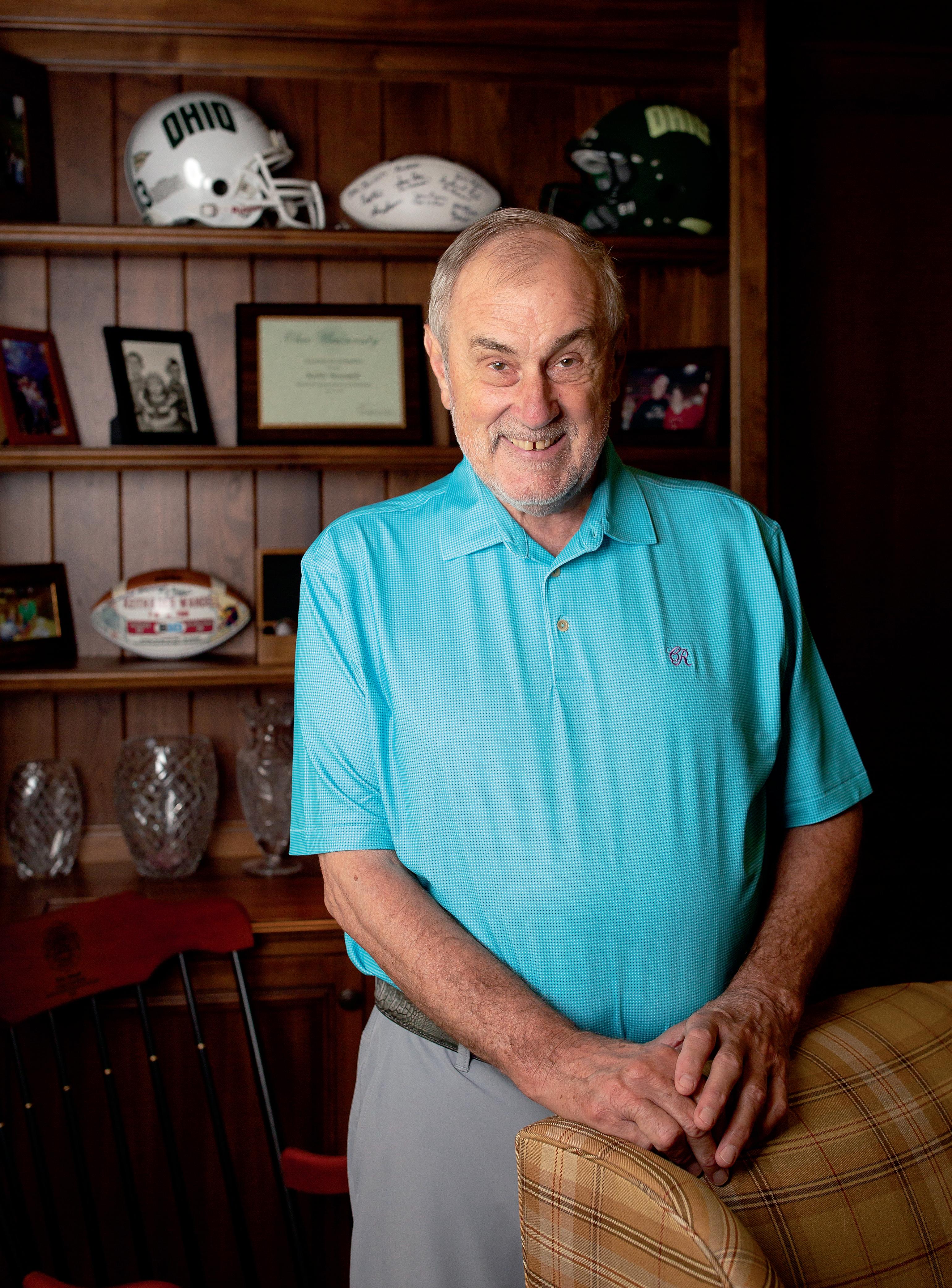
The Wandells’ remarkable generosity, alongside other donor contributions, has enabled the program to provide essential resources to help develop students’ leadership skills.
Jennifer Traxler, director of the Robert D. Walter Center for Strategic Leadership at Ohio University, describes 2022-23 as “a crescendo year” for the Wandell Leadership Fellows. “We’ve had a lot of opportunities for students to network with alumni,” Traxler says, noting trips to New York City, Denver and San Diego, and says her team is working to identify opportunities for students to network abroad. “We’re helping them become global leaders,” she says.
Students chosen for the Wandell Leadership Fellow program engage with a dynamic curriculum aimed at helping them discover their leadership identities. Fellows apply these valuable insights through visits with industry executives, networking trips and by engaging in community service.

Outgoing Wandell Fellows President Lauren Bailey, BBA ’23, credits the program for helping her develop her leadership practice. “Wandell Leadership Fellows has helped me learn about who I am as a leader and how to adjust my leadership styles to best fit the group around me,” she says.
Wandell says he wants the program to create exactly that kind of leverage for OHIO students.
“My hope is that they see the importance of leadership and that they stay committed without compromise,” Wandell says, acknowledging that in any leadership role, determination is required. While Harley-Davidson’s revenue jumped from $4.78 billion in 2009 to $6.23 billion by 2014, the company’s resurgence didn’t come without Wandell’s wherewithal for embracing change.
“It doesn’t mean saying yes to everything—sometimes you have to be really tough and make tough decisions,” he explains.
Wandell’s refining time at the Lima plant, where he eventually served as superintendent while earning his MBA at night, and his following turn as an executive at Johnson Controls Inc., helped build this resolve and created in him a steadfast dedication to the people he’s worked with and gotten to know.
“When you decide to take on the role of a leader, it becomes your primary obligation to protect [people] and their jobs and their future the best that you can,” he says. “It’s really about serving them.” —Sarah Filipiak, BSJ ’01, BS ’23
If you’re inspired by the Wandells’ commitment to shaping the future of Bobcat business leaders and would like to support The Keith and Deborah Wandell Leadership Development Program, visit ohio.edu/wandell. Your gift will help provide transformative opportunities for the next generation of outstanding leaders.
The Ohio River Valley contains some of the most resource-rich terrain in the world. Its settlement by humans, from the Indigenous mound builders to Johnny Appleseed, has been consequential not only for shaping the geographic and cultural landscape of the region, but also for forming the United States and the future of world history.
“Settling Ohio: First Peoples and Beyond” is a collection of essays edited by two Ohio University professors, Timothy G. Anderson (geography) and Brian Schoen (history). It also includes a foreword by former Ohio University president M. Duane Nellis and an afterword by Chief Glenna Wallace of the Eastern Shawnee tribe.

The book begins with an overview of the first people to inhabit the region, who built civilizations that moved massive amounts of earth and left an archaeological record that drew the interest of subsequent settlers and continues to intrigue scholars. It highlights how, in the 18th century, Native Americans who migrated from the east and north interacted with Europeans to develop impressive trading networks. Furthermore, the book shows how Native peoples managed wars and sought to preserve their existence in the face
of violent attempts to remove them from their lands.
Many people are familiar with the story of Ohio settlement that focuses on the Northwest Ordinance, the dealings of the Ohio Company of Associates and early transportation networks.
“Settling Ohio” weaves these historical milestones into a far richer story of contested spaces, competing visions of nationhood and complicated relations with Native peoples.
The book’s contributors show how chaotic and contingent early national politics and frontier development truly were. Chapters highlighting the role of apple-growing culture, education, African American settlers and the diverse migration flows into Ohio from the east and Europe further demonstrate the complex, multiethnic composition of Ohio’s early settlements and the tensions that resulted.
“Settling Ohio” recovers the oftenforgotten history of non-white peoples displaced by the processes of settler colonialism that has been, until recently, undervalued in both the teaching and study of the past. —Laura M. André is the publicity and metadata manager at the Ohio University Press
Many people are familiar with the story of Ohio settlement that focuses on the Northwest Ordinance, the dealings of the Ohio Company of Associates and early transportation networks. “Settling Ohio” weaves these historical milestones into a far richer story of contested spaces, competing visions of nationhood and complicated relations with Native peoples.
A nuanced story about the people and dynamics that reshaped this region and determined who would control itImage courtesy of the Ohio University Press
TIME MACHINE
As a student, you likely walked by the Soldiers & Sailors monument on a regular basis. But how much time did you spend wondering or learning about its history? If the answer is “none,” you’re not alone; as far back as 1959, it was referred to as the “mystery monument” in The Post.
Built in 1893, the iconic College Green structure celebrates its 130th birthday this year. And though it’s often considered an iconic fixture of the University’s central green, the monument actually was commissioned by Athens County. In fact, when the memorial was first unveiled before a crowd of around

8,000 onlookers, that portion of College Green was still owned by what was then the Village of Athens.
The monument honoring the 2,610 Athens County men who fought in the Civil War (roughly 1,000 of whom never returned) was unveiled on July 4, 1893. In May 1896, Athens council leased the rest of what we now know as College Green—including the monument—to the University in perpetuity. University pride in the monument arrived quickly, and it was even featured on the cover of the 1925 Athena yearbook.

At 45 feet tall, the concrete and bronze structure features a Union sailor, cavalryman and infantryman around its base and an artilleryman on top. Originally,
the monument included a set of canons and a stack of cannonballs nearby, but those were contributed to the World War II effort in the 1940s.
In the late ’60s, vandals removed one of the figures at the base and left it under a tree nearby; others graffitied peace symbols and antiwar messages on the figures and steps of the structure. This resulted in an ultimately unsuccessful bid by the Athens American Legion to relocate the entire monument.
In 1979, Soldiers & Sailors was included in an application to add several local sites to the National Register of Historic Places; today, College Green itself is listed as an official historic district. —Emma Henterly, BSJ ’10
* denotes accolades featured at ohio.edu/news or in the media
Susan Schuller Klein, BSJ ’64, was honored for 25 years of volunteer service as a docent for the Desert Botanical Garden in Phoenix, Arizona. Klein and her husband, retired Wall Street Journal columnist Fred Klein, live in Scottsdale, Arizona, on more than an acre landscaped with cacti and succulents.
1967
Martins Ferry, Ohio, native Linda Heil Dowler, BSED ’67*, was inducted into the Martins Ferry Hall of Honor in May. After graduating cum laude from OHIO, Dowler married and moved to St. Clairsville, Ohio (where she still resides). She retired from teaching for Martins Ferry schools after 30 memorable years.
1969
Pulitzer Prize-winning journalist Clarence Page, BSJ ’69, LITTD ’93, appeared in conversation with acclaimed author and journalist Wil Haygood in conjunction with the 2022 Dayton Literary Peace Prize last November. Page interviewed Haygood, who received the award, at the Victoria Theatre in Dayton, Ohio.
1970
Ohio Northern University professor emeritus
Stephen Iseman, BFA ’70, received an honorary doctoral degree from that university this spring. He joined ONU’s faculty in 1993 and retired in 2011; during that time, he started the college’s public relations major program, its chapter of the Public Relations Student Society of America (PRSSA) and its student-run PR firm.
David “Dee” Mowry, MED ’69, and his wife, Kathy Beavers Mowry, AB ’74*, were inducted into the Central Ohio Area Agency on Aging Hall of Fame in May. The Hall of Fame honors central Ohio older adults who share their dedication, talent and vitality in ways that significantly improve their communities and the lives of others. Kathy was the first woman elected judge in Fairfield County and has provided substantial pro bono legal services in the community; Dee is a professor emeritus at OHIO and has held a number of board seats and foundation memberships.
1972
Cuyahoga County attorney Patrick McLaughlin, BGS ’72, was elected to be the 2023 vice chair
Recognized for life beyond the stage
After a three-year pandemic hiatus, the Actors’ Equity Association and the Actors’ Equity Foundation have announced the 2021, 2022 and 2023 winners of its annual Paul Robeson Awards.
Dale Ricardo Shields, BFA ’75, MFA ’95*, received the 2021 award, which recognizes those who go beyond the

stage to enact their commitment to free expression, their belief in the artist’s responsibility to society, and their dedication to the betterment of humankind.
An actor, stage manager, director and educator, Shields has worked on Broadway, off-Broadway and around the country and has earned numerous awards throughout his career.
Julio Agustin, who nominated Shields for the award, says that the artist did not “expressly or intentionally set out to become an educator-activist. However, his belief in the artist’s responsibility to society resulted in an overwhelming need to represent, serve and uplift the next generation of theater professionals by actively sharing his extensive artistic knowledge with multiple and diverse audiences.” Read more at: ohio.edu/ shields-award
of the Ohio Board of Professional Conduct. McLaughlin, a fellow of the American College of Trial Lawyers, began his one-year term on Jan. 1.
The Minneapolis/St. Paul Business Journal named Diane Masterson Cross, BSED ’73, its 2022 Women in Business Career
Achievement honoree for her professional achieve-
ments and contributions to the region. She is the CEO and president of Fraser, a nonprofit provider of autism and early childhood mental health services in Minnesota, which she joined in 1989.
Zanesville City Schools inducted Eric Land, BSC ’73*, and 13 others into its Hall of Fame in May.
Land has a nearly 60-year career in television broad-
casting, including time with WOUB. In 1976, he and his wife, Cindy, established the Allan and June Land Award endowment at OHIO, which grants scholarships to students in the Scripps College of Communications.
This spring, retired attorney Catherine Bentz, BSED ’80*, received the 2022 Outstanding New Mentor award from SCORE Charlotte, a North Carolina–based volunteer organization that helps entrepreneurs start or grow businesses, in recognition of the number of mentoring sessions she held and her follow-up rate with mentees.
Jeffrey W. Gammell, BBA ’86, has been sworn in as the 101st president of the Ohio Land Title Association. Gammell earned his juris doctorate from Northern Kentucky University in 1991; he is the CEO of M&M Title Co. and a partner in law firm Gammell, Ross & Hoshor, LLC, both in Dayton, Ohio.
Former Ohio Supreme Court Justice Yvette McGee Brown, BSJ ’82, was named to Mahogany Columbus’ inaugural list of Most Influential Lawyers in Central Ohio.
McGee Brown was the first Black woman to serve on Ohio’s highest court when she took office in 2011. Today, she is the Partner-In-Charge of Diversity, Inclusion and Advancement at global law firm Jones Day.
Brown University has hired Tim Fitzpatrick, MED ’82*, as its senior associate director of athletics for facilities, operations and revenue generation. He has previously served as director of athletics and in other leadership roles at multiple universities. Most recently, he was CEO of the Diamond Sports Foundation.
In March, Phillip Pace, BSEE ’83, MSEE ’86, joined the nonprofit Institute for Defense Analyses as a research staffer in the Operational Evaluation Division of the institute’s Systems and Analyses Center. Pace earned his doctoral degree in electromagnetics, information theory and signal processing from the University of Cincinnati in 1990.
Richard C. Lewis, BBA ’83, MBA ’84*, retired from his position as executive director of the Ohio School Boards Association in May. He
OHIO alumni publish books across subjects and genres. Here are releases within the last year.
Social Media, Social Justice and the Political Economy of Online Networks, digital culture and social sciences (University of Cincinnati Press), by Jeffrey Layne Blevins, PHD ’01, and James Lee · Heresy in the Heartland: The Controversy at the University of Dayton, history and religion (Catholic University of America Press), by Mary Jude Wahrer Brown, BSED ’72 Suds Series: Baseball, Beer Wars, and the Summer of ’82, sports history (University of Missouri Press), by J. Daniel, BSC ’91 · Knowing When: Poems, poetry, (Mercury HeartLink), by Mark Fleisher, BSJ ’68 · The Journey of an Old White Dude in the Age of Black Lives Matter: A Primer, social justice/memoir (Koehler Books), by John R. Gerdy, MSA ’83, PHD ’86 · A Diversity of Photo Essays & Glimpses of Life Before COVID, photo essay (self-published, Barnes & Noble Press), by Jim Golding, BSJ ’72 Race in the Crucible of War, history (University of Massachusetts Press), by Gerald Goodwin, PHD ’14 · Stringbean: The Life and Murder of a Country Music Legend, biography and music (University of Illinois Press), by Taylor Hagood, BA ’98, MA ’00 · The Blue Wife Poems, poetry (Kelsay Books), by Hayley Mitchell Haugen, PHD ’06 · In the Dark, children’s picture book (Penguin Random House), by Kate Hoefler, BA ’01 · The Bottle Conjuror, historical fiction (Beck & Branch Publishers), by John Kachuba, MA ’03, and Jack Gagliardo · Haycorn Smith and the Castle Ghost, middle grade mystery (Paper Angel Press), by John Kachuba, MA ’03 · Mitan & Moni: The True Story of Two Swedish Sisters Chasing the American Dream in 1960s California, biography and fashion (self-published), by Jenny Levallius, BSJ ’98 · Limp Forward: A Memoir of Disability, Perseverance, and Success, memoir (Lioncrest Publishing), by Libo Cao Meyers, MS ’03, PHD ’04 · Beyond the Voting Rights Act: The Untold Story of the Struggle to Reform America’s Voter Registration Laws, political science (De Gruyter), by Gregory T. Moore, BSC ’83, MPA ’21 · Career Roadmap: Setting Yourself Up to Reach Your Career Aspirations, career and self-improvement (self-published, Greta Oliver Consulting), by Greta Oliver, PHD ’06 · The Violence of Reason, historical fiction (Enceladus Literary LLC), by Pete Planisek, BSC ’99, MED ’04 · Olly & The Spores of Oak Hill, fiction (self-published), by Glenn Somodi, BSJ ’92 Sketches: Memories of Our Journey, memoir (self-published), by Robert Trocchia, BSED ’61
Send your published work updates to ohiotoday@ohio.edu or to Ohio Today, Ohio University, P.O. Box 869, Athens, OH 457010869. And don’t forget to add your achievement to the Alumni Association’s Bobcat Authors database at ohio.edu/alumni/ bobcat-authors
spent his entire career with the association and became executive director in 2006. Lewis said in a press release that being involved with OSBA was both a privilege and a personal calling.

William R. Wyss Jr., MA ’84, recently accepted the position of curriculum site coordinator at Northeast Ohio Medical University (NEOMED). In that role, he is responsible for assisting third- and fourthyear medical students who are completing clinical clerkships at University Hospitals in Cleveland.
The Delaware County Republican Central Committee selected Jeffrey Balzer, BGS ’84*, to serve as the county’s sheriff. He
will finish former Sheriff Russ Martin’s term, which ends in early 2025. Before joining the Delaware County Sheriff’s Office in 2016, he served as a Deputy U.S. Marshal for the Southern District of Ohio.
Ronald Seide, BBA ’85, along with Willow Mattison, BS ’22, and OHIO class of 2024 student Logan Richards, ran a Kickstarter campaign for their window covering startup, LightScreen Art, in May following a start in the OHIO Innovation Center and nearly two years of development. The product uses shatterproof acrylic to replicate the look of stained glass at a fraction of the price.
Matt Gruber, BSC ’87, is re-releasing Four Dead in Ohio, an album from his college band, Slam Whitman, that was produced on cassette in 1985 in the RTV Communications Building. The band debuted at a Battle of the Bands show that year, then opened for the Ramones at Memorial Auditorium shortly after.
International nonprofit Business Council for Peace has named Susan “Susy” Cheston, MA ’87*, as its new chief growth officer. She credits her time at OHIO, and working for WOUB, as inspiring her passion for addressing international poverty issues.
Jim Piatt Jr., BSJ ’87, MBA ’93*, has been named the senior vice president for university advancement and external affairs at Elon University in North Carolina. Piatt has been with the university for 14 years, serving leadership roles in development, alumni relations and parent relations programs.
Emmy award-winning producer and Queer Eye creator David Collins, BSC ’89*, returned to OHIO to speak at the morning undergraduate commencement ceremony. He was joined by afternoon undergraduate speaker Mike DeNoma, AB ’77*, an experienced chairman and CEO at leading emerging market
The former housemates of 9 S. Congress St. reunited, 30 years later, at Sequoia Grove Winery in Napa, California. Pictured from left to right are Sharon Bok Hodges, BSJ ’93; Emily Miller Vieux, BBA ’93; Rebecca Roman Jenkins, BS ’96, BSPT ’96; Jeannie McGogney Schott, BSJ ’93; Heidi Gagnon Griesmer, BSJ ’93; Kim Smith Swope, BS ’93; and Karen Dozer, BBA ’94, BSHCS ’94
David Terry, AB ’90, MA ’92, took his Bobcat pride— and flag—on a trip to Bermuda during the last two weeks of June.

Bobcat footprints showed up near the South Pole when Christian C. Dussing, BBA ’74, visited the Antarctic Peninsula in March 2023.
Self-described “friends forever” Bob Hoffman, MED ’84; Cheryl Paskievitch Hoffman, BSHSS ’80, MAHSS ’82; Cindy Waddell Howe, BSED ’80; and Chuck Howe, BS ’80, represented the Bobcats at Tanzania’s Ngorongoro Crater in October.
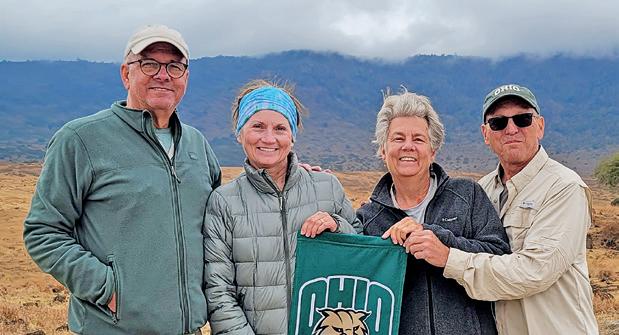
Newlywed Noelle Policastro Bach, BMUS ’09, and husband Drew Bach gathered Noelle’s fellow OHIO alumni at their Long Island, New York, wedding in September 2022. Pictured are, front row from left, Jayme Dyrdek, BSED ’08, MA ’10; Alyssa Mehling Smith, BSJ ’10; Kari Resler Saunier, BBA ’10, BSED ’10, MED ’12; middle row from left, Dustin Saunier, BSS ’07, MBA ’13; Jerod Smith, BMUS ’10, MM ’14; Noelle and Drew Bach; top row from left, Gregory Hilgeman, BMUS ’09; Jennifer Zink Yurkovich, BMUS ’09; Jim Dyrdek, BGS ’77
Alumna Lindsey
Elling Thompson, BSJ ’05, and her son (future Bobcat?) Gavin showed off their OHIO pride in Innsbruck, Austria, last December.


In recognition of Alden Library’s Cornelius Ryan Archive, Joseph Greene, BSJ ’73, visited “A Bridge Too Far” in Arnhem, Netherlands.
Send your photos with names, grad degrees and years to ohiotoday@ ohio.edu or to Ohio Today, Ohio University, P.O. Box 869, Athens, OH 45701-0869.
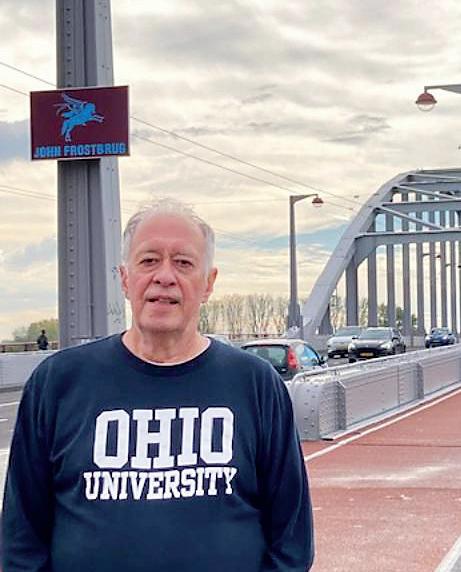
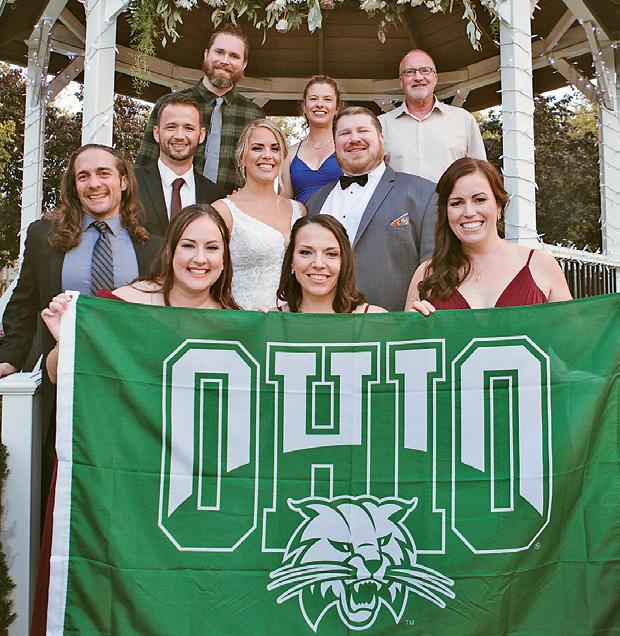

Maverick James Nyeste, born April 14, 2023, was showing his Bobcat pride before he even left the hospital! He is the son
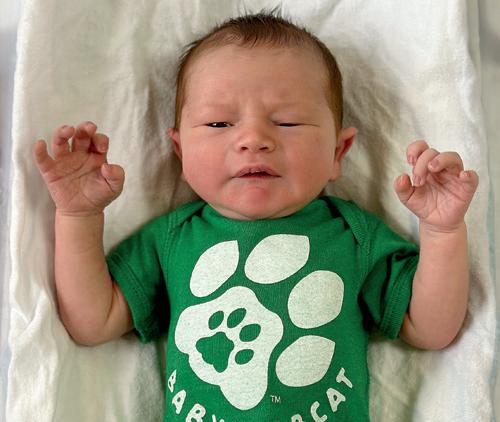
of Anna Quehl Nyeste, BSSPS ’09, and Corbin Nyeste, BBA ’10 Briana Redmount, BFA ’12, and daughter Serabellia Olson, class of 2044, are ready to cheer on their Bobcats!
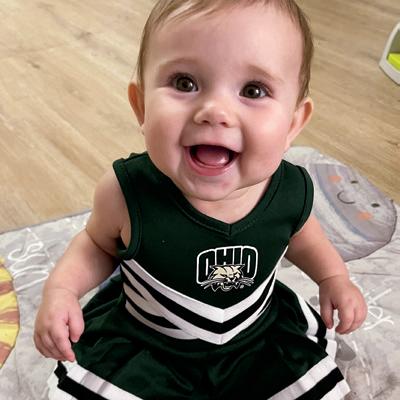
Future engineer Linus and artist Lucy are the children of Kyle Addis, BSCHE ’11, MS ’14, and Thu Tran Addis, PHD ’14; they also are the nephew and niece of Josh Addis, BSCHE ’05, MS ’08


Cameron Alexander Miller was born March 19, 2023, to Greg Miller, BSJ ’98, and his wife, Carly. Cameron made his first visit to Athens in mid-April.

Jessica Lawrence Vicknair, BSC ’03, and Payton Vicknair have a house full of future Bobcats! Their 4-year-old, Braxton, was joined by twins Liza and Vance in 2022.



banks, and graduate speaker Saumya Pant, MA ’00, PHD ’07*, an assistant professor in OHIO’s School of Media Arts and Studies and director of the Communication and Development Studies program in the Center for International Studies.
Iowa State University’s College of Agriculture and Life Sciences awarded its 2023 Outstanding Service in Student Recruitment and Retention Award to Ebby Luvaga, MA ’90, PHD ’96, for her work as the primary advisor for all first-year agricultural business students, coordinator for undergraduate academic advising in the department, and supervisor for the student peer mentor team in the department’s learning communities.
People magazine profiled Debra “Debbie” Sarich, BSPT ’90, for her remarkable adoption journey as a single mother. Over the last 16 years, Sarich has adopted seven children with special needs from all around the globe. The pediatric physical therapist told the magazine, “I have made it my life’s work to provide physical therapy for these children, so why not open my heart and home to them as well?” Sarich’s family
includes Krasimira and Lucy, both 19; Sergio, 16; Kaitlyn and Evan, both 15; and Tray and Sadee, both 12, as well as seven dogs, two cats, three aquatic turtles and several fish.
“The 90s Club,” the first feature-length documentary produced by Sheri Martis Ward, BSJ ’90, is now available on Amazon Prime Video. She and director/producer Robert Darwell featured 12 seniors in their 90s, including Dick Van Dyke, the world’s oldest performing drag queen and others. Ward also recently completed her second documentary film, “Black Uniform,” which explores the stories of 12 Black veterans. She is currently submitting it to film festivals.
Fort Washington Investment Advisors, Inc., has named Krista Lindberg Rivers, BBA ’92, vice president of consultant relations. In this newly created role, she will lead the agency in developing and maintaining relationships with institutional investment consultants across the country.
Ben Holt III, MS ’96*, was named vice president for innovation at AgBiome. The certified B-Corp. works to enhance global food
production, human and animal health, and more. Holt joined AgBiome in 2019 after earning his Ph.D. in molecular biology from University of North Carolina Chapel Hill.
Mackenzie Weaver Betts, BSJ ’98, has joined the Thomas P. Pappas & Associates publicity consulting firm as its director of association management. She had previously served in leadership roles for a number of state associations and local organizations. She has a master’s degree in marketing and communication from Franklin University.
Brad Chute, AA ’02*, was appointed to fill the Newark City Council at-large vacancy created when the former councilmember left for a state position. Chute will complete the term, which runs through the end of this year, and will fill the spot on the November general election ballot.
Vanguard Veteran, a support organization for veterans who have recently returned home founded by Kathryn “Kathy” Lowrey Gallowitz, MA ’04, was recently featured in several
media outlets, including the Phoenix Business Journal as one of the publication’s “People on the Move.” Gallowitz is a retired lieutenant colonel of the U.S. Air Force.
Janelle Blazier Golloway, BBA ’05*, was sworn in as assistant county manager for Onslow County, North Carolina, in May. She originally joined the county in 2016 as its deputy human resources director and has served as human resources director for the past four years.
Elyria Catholic High School in northern Ohio recognized Joanne Romero Loos, BSJ ’06*, in its 2023 Distinguished Alumni Awards, which recognizes former students who have remained steadfast examples of the school’s pillars of excellence, compassion, faith, tradition and community.
Carolyn Bailey Lewis, PHD ’07, was inducted into West Virginia University’s WVU Alumni Association Academy of Distinguished Alumni. She earned her bachelor’s degree in journalism from WVU in 1971 as the first Black woman to graduate from the school’s Reed College of Media, where
she also earned her master’s degree in 1987. She was director and general manager of WOUB Public Media for 13 years and now is its director and general manager emerita.
Poet Carrie Oeding, PHD ’07*, earned the Akron Poetry Prize for her latest book, “If I Could Give You A Line,” which was released in March. This is her second poetry collection; the first, “Our List of Solutions,” won the Lester M. Wolfson prize in 2011. “If I Could Give You A Line” explores themes of motherhood, visual art, confience and uncertainty. It’s available from UA Press Catalog, Amazon and other book retailers.
Derik Taylor, BSS ’06*, has opened Elder Law of Eastern Kentucky, PLLC, in Ashland, Kentucky. His practice focuses on seniors’ needs, including Medicaid crisis, estate planning and special needs trusts.
In March, Beth Stinson Prather, BSED ’08, transitioned from her role as a secondary education teacher in central Kentucky, which she held for 15 years, to a position at Asbury University as an instructional designer. She also holds a Master of Science in Education,
with a special focus on curriculum and instructional design, from Arkansas State University.
Matt Houser, BSC ’08, partner at Nashville-based production company Taillight, was executive producer on the official music video for “Standing Room Only” by country music star Tim McGraw. The video was released in May.
Financial publication
Barron’s has hired Megan Leonhardt, BSJ ’10*, as a senior writer. She previously covered labor, financial and economic trends at Fortune and has held reporting roles at CNBC and Money magazine.
The Jewish Federation of Cleveland’s Young Leadership Division (YLD) named Jonathon Nisenboum, BBA ’11, its board chair in January 2023. The YLD connects Jewish young adults through a variety of social and philanthropic activities. Nisenboum has previously served in a number of other vice and co-chair roles with the organization.
Emily Bloom Jackson, BSN ’12*, served as
Presidential honors for volunteerism
Althea Brown, BSC ’75, received a 2022 Joseph R. Biden Lifetime Achievement Award and a Presidential Volunteer Service Award medal in August 2022. The medal recognizes a specific number of service hours performed in a given year, while the Lifetime Achievement Award is bestowed upon those who have performed more than cumulative 4,000 hours of service.
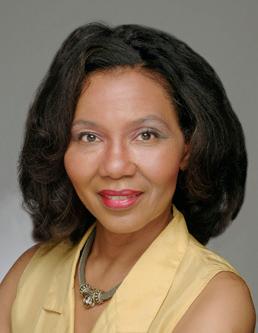
Professionally, Brown is a creative director at Film Raconteur and a producer, director, editor and animator at VVE, both companies that she founded. She has an MFA in film and television from Savannah College of Art and Design and has won 30 national film and video awards over the course of her career.
Founded in the early 2000s, the President’s Volunteer Service Award has continued under each administration to recognize American citizens (and lawful permanent residents) whose service has a positive impact on their communities and inspires those around them to take action, too.
commencement speaker for Southern State Community College. She earned two associate degrees from SSCC before getting her BSN at OHIO while working full-time at Mercy Hospital in Cincinnati. She then obtained her CNP at the University of Cincinnati and moved back to her native Highland County.
Holy Cross District High School in Covington, Kentucky, has named former
OHIO basketball player Ricardo Johnson, BSC ’14*, as its new basketball coach. Johnson is the 17th coach in the school’s history.
Wickens Herzer Panzo Co., a 91-year-old law firm in northeast Ohio, has added Emily M. Peterson, BSJ ’16, as its newest attorney, practicing in corporate and business law. She earned her juris doctorate from Case Western Reserve University.
The Ohio University Press awarded its 2023 Hollis Summers Poetry Prize to Katie Berta, PHD ’17*, for her first book, “Retribution Forthcoming,” set to be published in April 2024. Currently the managing editor of The Iowa Review, Berta credits her time at OHIO as integral to the poems in her book.
In April, Tarell Basham, BSS ’16*, signed a oneyear agreement with the Cincinnati Bengals as a free agent. During his time at OHIO, he earned Freshman All-America honors and was chosen as Player of the Year in the Football Bowl Series Mid-American Conference (MAC) after his senior campaign.
Amanda Warren, BSN ’18*, was inducted into the Washington County Career Center Alumni Hall of Fame this spring. She now works at Selby General Hospital in Marietta, Ohio, and is a parttime clinical instructor at University of Rio Grande.
U.S. Soccer appointed Ciara Crinion, MSRSS ’17*, as the new head coach of the US Under 15 Women’s Youth National Team. She has more than a decade of experience
coaching collegiate soccer, including her most recent position as head coach at Seton Hall, and has served as an assistant with the U-20 Women’s Youth National Team.
Former OHIO football safety Alvin Floyd II, BSPE ’20, MSRSS ’22*, has returned to the university as the football program’s assistant strength and conditioning coach. He previously interned with the program in May and June 2022, designing workout programs amid other duties.
Kaieem “Kai” Caesar, BSC ’20, MSMGT ’22, MCOMM ’23*, signed with the Baltimore Ravens as a defensive tackle. He played for OHIO in undergrad and as a graduate student, serving as team captain in his final year with the university.
Dorian “Dori” Gray, BSJ ’23*, joined The New York Times this summer as a Dow Jones News Fund editing intern, working on the paper’s Flexible Editing desk. At OHIO, Gray served as managing editor of Thread Magazine and wrote for both The Post and Southeast Ohio Magazine. Bobcat Tracks
Feb. 6-15 United Arab Emirates
Feb. 16-23 Cuba & its People
Feb. 24 -March 10 Dazzling Oceania — Australia & New Zealand

April 10-13 The Masters
April 21-29 Southern Charms
April 26 -May 4 River Life Along the Dutch Waterways
May 13 -June 4 Essential Europe
May 16-24
May 16-27
June 18-29
July 13-23
Cotswolds Escape

Europe’s Romantic Rivers & the Alsace Region
Great Journey Through Europe
Oceania Cruise — North Sea Escapade
Aug. 6-16 Oceania Cruise — Radiant Alaska
Oct. 8-17
Italy — Tuscany & Emilia Romagna
Nov. 4-14 Oceania Cruise — Renaissance
Scan the QR code or visit ohio. edu/alumni/experience/travel/ alumni-tours-2024

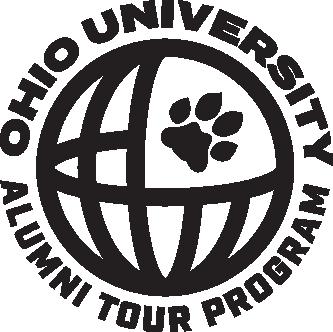
Betty (Sauer) Galyon, BSED ’44
Carlene E. (Ross) Clark, BSED ’46
Shirley M. Burns Conroy, BSED ’46
Margaret Krivonak, SC ’47
Catherine O. (Drake) Smith, AB ’48
Robert D. Johnson, BS ’49
Harry P. Schrank Jr., BSCOM ’49
James E. Brandau, BSED ’50, MA ’57
Paul A. Eisenberg, BCOM ’50
David N. Keller, BSJ ’50
Julia J. Nehls, MSHEC ’50
Evelyn M. (Yoe) Jarosick, AB ’51
Clara A. (Pistilli) Schesky, AA ’51
Diana (Galbreath) Welch, AB ’51
Ruth E. (Kaber) Zake, BSHEC ’51
John M. Elliott, MS ’52
Dow H. Finsterwald, AB ’52
Robert F. Gaynes, BSCOM ’52
Frances M. (Petras) Norman, BSED ’52
James R. Patrick, AB ’52
Edward J. Rynes, BSCOM ’52
Eugene A. Sauder, BSCOM ’52
Steven Timonere, BSCOM ’52
Judith A. (Betts) Wysong, BFA ’52
Paul M. Bowers, BSED ’53
Robert “Bob” W. Harmon, BSME ’53
Neal A. Lindsley, BSCOM ’53
Ruby P. (Tignor) Riedel, BSED ’53
Van (Havel) Stryk, BSJ ’53
Jerry Jagers, AA ’54
Joseph A. Kocab, AB ’54, MED ’55
Mary F. (Athearn) Matson, BFA ’54, MFA ’58
Ellen (Guzley) Oakley, BSED ’54
Jocelyn S. (Cady) Ritter, BSC ’54
Glenn E. Romanek, BFA ’54
Glenn A. Waggy, BSED ’54
John M. Dunnette, BSED ’55
Mona (Tryon) Hobson, BSED ’55
Barbara (Defenbaugh) Meade, BSED ’55
James S. Meyer, AB ’55, MA ’57
Richard T. White, BSCOM ’55
Lanny E. Beekman, BS ’56
Carole K. (Godfrey) Hayden, BFA ’56
Eleanor M. (Ewing) Lansell, BSED ’56
Harley F. Mooney Jr., MA ’56, MA ’70
Gladys E. (Bukowski) Pope, BSED ’56
Doris (Roth) Weakland, BSCOM ’56
Ardis J. (Allen) Thomas, BSED ’57
Eugene J. Vejsicky, BSED ’57, MED ’67
William “Bill” B. Weaver, BSED ’57
Charles “Charlie” H. Barndt, BSCOM ’58
L. Dale Dickens, BFA ’58
Wallace K. Guenther, BSJ ’58
Robert L. Henshaw, BSCOM ’58
Glenn A. Himebaugh, BSJ ’58, MS ’59
Dennis W. White, AB ’58
Carolyn S. (McFarland) Young, BSED ’58
Barbara L. (Seifert) Barndt, BFA ’59
Seldon L. Carsey, BSAGR ’59
Sophia “Sophie” Hadjian, BFA ’59
David J. Klekner, BSIT ’59
Theodor P. Krauss, AB ’59
Dolores (Mroczka) Thompson, BSED ’59
Anne E. (Goddard) Barker, BSHEC ’60
James V. Buchanan, BSJ ’60
Doris J. (Dailey) Forror, BSED ’60
John S. Gordon, BSME ’60, MS ’65
Elizabeth A. (Hathaway)
Henderson, BFA ’60
Carole S. (Neeb) Lear, BSED ’60
Martin T. Lenhard, BSED ’60
Ivan N. Miller, BSME ’60
Patricia A. (Gahagan) Chase, BS ’61
William D. Coats, BSED ’61
Brantley B. Deaton, BSEE ’61
Mary L. (Hines) Kelly, BSED ’61
Nancy (Vaughan) Cullman, BSED ’62
Jerome C. Gorby, BSCOM ’62
Thomas E. Shoemaker, BSCOM ’62
John P. Wagener, BSCOM ’62
Richard “Dick” E. Adcock, BBA ’63
John W. Berger, AB ’63
Mary K. (Oddou) Cochran, BSED ’63
Julie C. (Hollingsworth) Miller, BFA ’63
Robert M. Firis, BSJ ’64
Marilyn (Langer) Mangus, BSJ ’64
George M. Manuselis Jr., BS ’64
Bernard B. Spiegel, BSED ’64
John D. Bee, BA ’65
Myrtle L. (Williams) Bell, MBA ’65
Harold H. Brown, BS ’65
Dana (Wilson) Goff, BFA ’65
Roberta J. (Ashley) Medress, BA ’65
Neil L. West, BSME ’65, MS ’66
Donald L. Westfall, BSED ’65
Robert L. Boyd, BSED ’66
David C. Buckles, BSME ’66
Carol J. (Hill) Gleim, BSED ’66
William A. Harmon Jr., BBA ’66
Thomas G. Kish, BBA ’66
Robert “Bob” B. Andersen, BSCHE ’67
William R. Brown, BBA ’67
David E. Carter, MS ’67
Drell H. Goff Jr., BBA ’67
Marilyn A. (Johnston) Greenway, MA ’67
Patricia A. (Horne) Hines, AB ’67
John “Jack” E. Kappeler, BBA ’67
Patricia (Dietrich) Nantz, BSED ’67
Anthony C. Nickras, AB ’67
Edward L. Palmer, MS ’67, PHD ’70
Elizabeth J. (Sasser) Elmore, BSED ’68, MED ’71
Richard M. Fulks, BS ’68
Gary A. Mayer, BBA ’68
Jerry F. Medley, MS ’68
Gary K. Schwartz, MS ’68
Mary E. (Christman) Helber, BSED ’69, MED ’75
Susan J. (Starbird) Martin, BSHSS ’69, MA ’71
Frederica Gaffney, BSC ’70
Carol J. Gardner, AB ’70
Dennis P. McCormack, BS ’70
Jo E. (Robb) Packard, BSED ’70
Thomas C. Watters Jr., BBA ’70, MBA ’72
James G. Zimmerman, BBA ’70
Mark F. Ellis, AB ’71
Bruce E. Stannard, BGS ’71
Michael L. Uhrig, BBA ’71
Monica A. Boles, MED ’72
Robert E. Burnham, BSED ’72
Janet E. (Mattson) McComb, BSED ’72, MED ’79
Rand R. McFarland, BFA ’72
James H. Sheppard, BBA ’72
William R. Barrett, MED ’73
George L. Freeman IV, BSC ’73
Roxanne (Masholan) Geerin, BGS ’73
Gloria B. (Glanco) Loyd, MA ’73
Molly (Zwerling) O’Byrne, AB ’73
Margaret Goessling Reiser, BFA ’73, MA ’90
Blair R. Williams, AB ’73
David F. Wurst, MFA ’73
William H. Brown, BGS ’74
Eric E. Peterson, BBA ’74
Dennis G. Printz, BSED ’74
Danny R. Robinette, PHD ’74
Jonn L. Simmons, BSED ’74, MED ’83
Cynthia “Cinny” A. (Lephart) Worthington, BSED ’74
Dennis G. Bayuzick, MFA ’75
Allen H. Davis, BFA ’75
Rose A. (Morella) Dikis, BSJ ’75, MBA ’76
Della L. Partridge, BGS ’75
David A. Ashworth, BSED ’76
Ella (Miller) Thompson, BGS ’76
Andrea L. (Williams) Utts, BFA ’76
Laurence A. Walczak, MA ’76
Diane (Linn) Burney, BSED ’77
Faye Berry Klahn, MSHEC ’77
William Majewski, AB ’77
Kenneth J. Stead, BBA ’77
Charles H. Straight Jr., MBA ’77
Mary O. Black, MED ’79
A. David Swearingen, BBA ’80
Jay M. Thomas, BMUS ’80
Thomas J. Volk, BS ’80
Joseph W. Eberly, AB ’81
David H. Kellner, MBA ’81
Beth A. (Hassenpflug) Mansperger, MA ’81
Lisa J. Clark, BFA ’82
Randy J. Bardonner, MA ’83
Natalie A. (King) McLain, BSED ’83, MED ’87
Beth A. (McHenry) Thomas, BSC ’83
Ana C. Ungar, AB ’83
Marilyn (Price) Combs, MED ’84
William E. Kiser, MED ’84
William W. Evans Jr., BBA ’85
Anita S. (Ackerman) Mayfield, BBA ’85
William L. Ramage, MBA ’86
Roger D. Hall, BSPE ’87
Alan W. Adkins, BBA ’88
Matthew R. Bell, BGS ’90
Daniel T. Fritz, BSC ’90
Clare M. Hanusz, AB ’91
Danette M. (Wood) Baker, MFA ’92
Alicia G. (Misner) Layne, AAB ’93
Amy L. Stankiewicz, BA ’94
John R. Ortli, BSCE ’95
Janet E. Kearney-Gissendaner, PHD ’97
Jane L. (Harris) Iandolo, AA ’98, BSS ’03
Trevor M. Walsh, BS ’99
Jeffrey M. Gardner, BSCHE ’07
Russell Crooks, MA ’10
Lisa J. Belkofer-Bake, BSN ’18
Allison L. Skeans, BSAM ‘19, MBA ’22
Patricia A. (Check) Altman, MBA ’81, Uniontown, Pennsylvania, former chief administrative officer, Jan. 20.
Ralph Bernard, Phoenix, Arizona, former air quality technician, Mar. 15.
Charles C. Bowling, Kitts Hill, Ohio, former OHIO Southern contractor, Feb. 6.
Darrell L. Brown, The Plains, Ohio, former equipment operator, Apr. 20.
Cleveland O. Bryant, BSED ’70, Leander, Texas, former head football coach, Jan. 31.
Rosemary J. Campbell, Columbus, Ohio, former custodial worker, Feb. 3.
Gloria I. Devol, Athens, Ohio, retired library specialist, Mar. 28.
Jennifer Dillavou, Champaign, Illinois, former AVP of alumni relations/executive director of Ohio University Alumni Association, Apr. 29.
Dr. William “Bill” H. Frederick, Owls Head, Maine, retired professor emeritus of history, Mar. 2.
David R. Fritchley, Athens, Ohio, former computer services director, Feb. 9.
Daniel R. Hieronimus, BGS ’84, Ironton, Ohio, Safe Schools coordinator, Jan. 26.
Dr. Ronald H. Isaac, Athens, Ohio, retired assistant professor of meteorology and geography, Jan. 13.
Dr. Winfried “Vinny” Just, Athens, Ohio, mathematics professor, Nov. 2.
Paul L. Kilzer, Millfield, Ohio, former storekeeper, Apr. 4.
Roger D. Lafollette, New Marshfield, Ohio, retired groundskeeper, Dec. 3.
Linda L. McDonald, Nelsonville, Ohio, retired payroll records specialist, Jan. 2.
Dr. Joan F. (Scanlon) McMath, Hudson, Ohio, professor emerita of teacher education, Feb. 11.

Dr. Scott M. Moody, Albany, Ohio, associate professor emeritus of biological sciences, Jan. 4.
Grace Myers, Chillicothe, Ohio, former senior secretary, Jan. 5.
Dr. Marjorie E. (Nelson) Perisho, State College, Pennsylvania, retired associate professor in the Heritage College of Medicine, Dec. 29.
Dr. Catherine “Cay” (Hall) Roberts, MA ’72, PHD ’81, Waverly, Ohio, former professor of English, Feb. 9
Paul Ross, Chauncey, Ohio, retired communication network specialist, Nov. 16.
Nancy H. (Huffman) Rue, Athens, Ohio, retired coordinator of user services, Feb. 4.
James “Jim” Sabin, BSJ ’95, Canal Winchester, Ohio, media relations manager, Jan. 27.
Arlen Saunders, Liberty Township, Ohio, retired associate professor emeritus of industrial engineering, Apr. 9.
Dr. Larry E. Snyder, Athens, Ohio, retired professor emeritus of mathematics, Jan. 21.
Erin K. Thompson, Athens, Ohio, former executive assistant, Jan. 13.
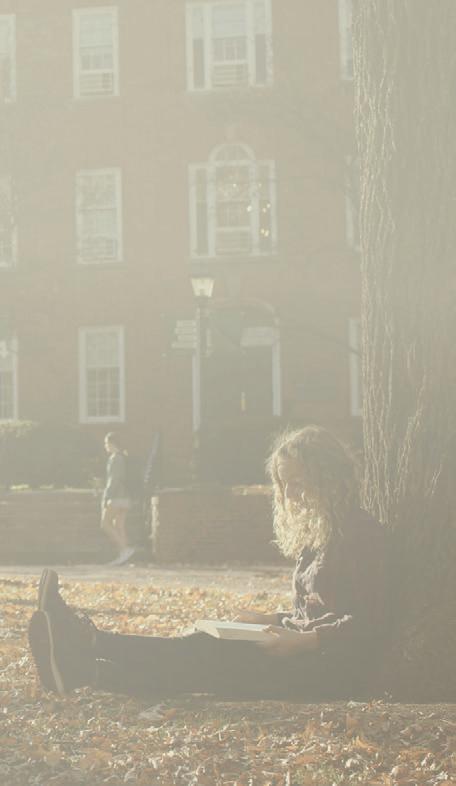
Dr. Ivan M. Tribe, BSED ’62, MA ’67, McArthur, Ohio, former WOUB program host, Apr. 4.

Dr. Joseph B. Tucker, Athens, Ohio, retired professor emeritus of political science, Nov. 28.
Phyllis S. Walton, Ironton, Ohio, OHIO Southern retired science lab instructor, Feb. 7.
Marie P. (Phillips) White, AA ’52, Athens, Ohio, retired administrative assistant to the president, Jan. 14.
Peggy L. Woods, Newcomerstown, Ohio, former custodial worker, Dec. 30.
Dr. Louis E. Wright, Athens, Ohio, retired professor emeritus of physics, Feb. 7.
Dr. James Yanok, Kent, Ohio, retired professor emeritus of teacher education, Mar. 23.
Anita G. Yates, The Plains, Ohio, retired administrative associate, Mar. 6.
—Includes individuals who passed away between Nov. 1, 2022, and Apr. 30, 2023. Information provided by the University’s Office of Advancement Services and the Office of the University Registrar.
you could give to someone than helping contr ibute to the education of f uture gener ations, I can’t imagine a greater legacy to my entire family than to give back to the Univer sit y.” ’
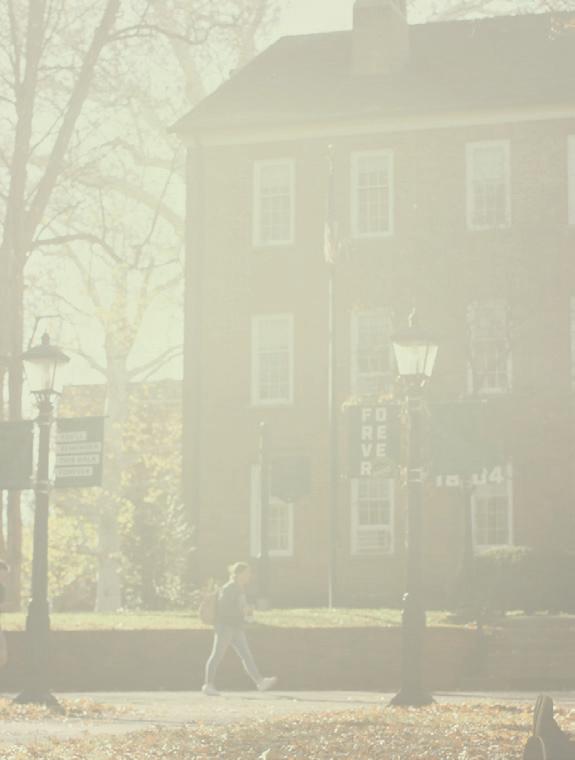
MISSION STATEMENT
Ohio Today informs, celebrates, and engages alumni, faculty, staff, students, and friends of Ohio University.

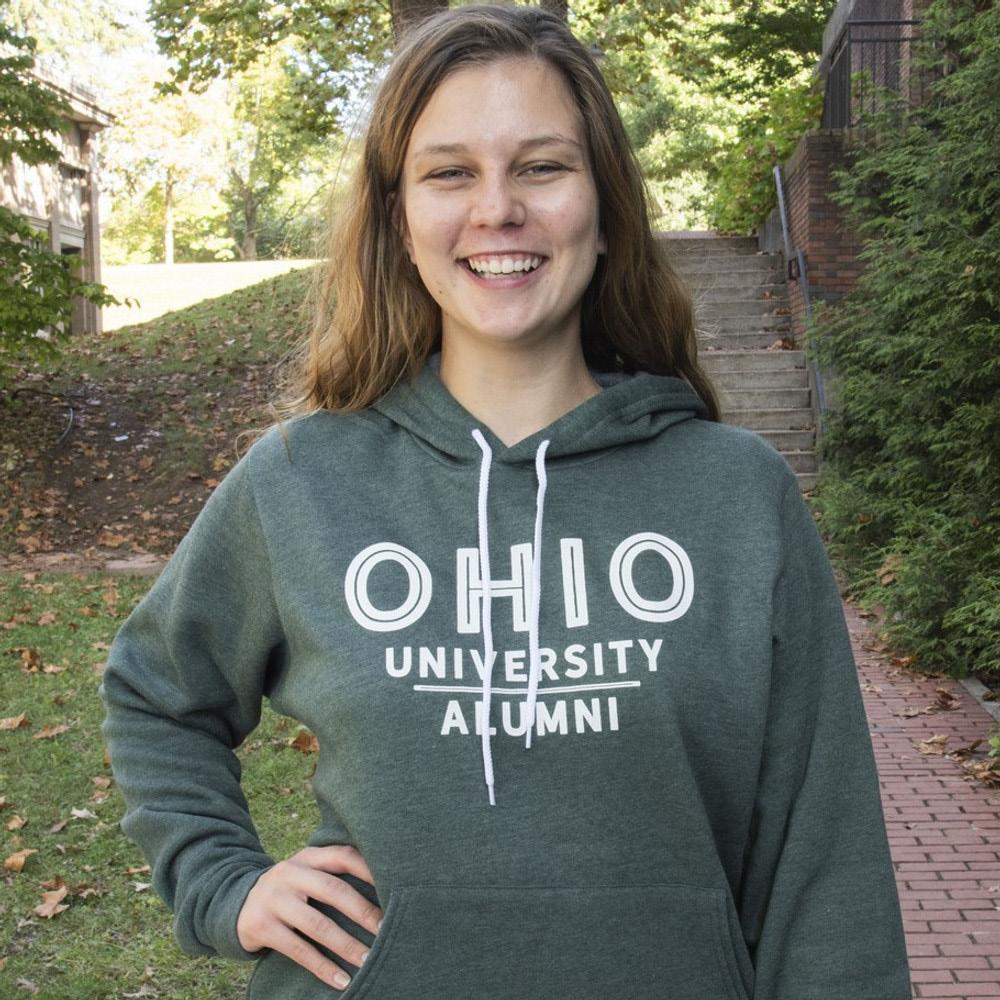
Editor in Chief
Emma Henterly, BSJ ’10
Art Director
Sarah McDowell, BFA ’02
Contributors
Advancement Services Operations Team
Laura M. André
Jessie Balmert, BSJ ’09
Dylan Benedict, BSVC ’22
Eli Burris, BSJ ’16
Nick Claussen, BSJ ’92
Madeline Gray, MA ’12
Granger Images
Rich-Joseph Facun, BSVC ’01
Sarah Filipiak, BSJ ’01, BS ’23
Aaron Harden, BFA ’08
Cat Hofacker, BSJ ’18
Office of the University Registrar
Ohio University Mahn Center for Archives & Special Collections
Ohio University Press
Robin Oliver
Daniel Owen, BSVC ’15, MA ’19
Abbey Phillips, BSVC ’19
Brooke Preston, BSS ’02, MC ’23
Stephen Reiss
Ben Wirtz Siegel, BSVC ’02
Carmen Szukaitis, BSJ ’24
Dylan Wayne Townsend, BSVC ’24
Ty Wright, BFA ’02, MA ’13
Ohio University President
Dr. Lori Stewart Gonzalez
Vice President for University
Advancement and President and CEO of The Ohio University Foundation
Nico Karagosian
Vice President for University Communications and Marketing
Robin Oliver
Senior Director of Communications
Dan Pittman, BSJ ’03
Director of Content Strategy and Publications
Sarah Filipiak, BSJ ’01, BS ’23
Printer
The Watkins Printing Co.
Ohio Today is published two times a year. Its digital companion is ohiotoday.org. Both are produced by University Advancement, with funding from The Ohio University Foundation. Views expressed in them do not necessarily reflect the opinions of the staff or University policies.


Editorial office address: Ohio Today, Ohio University, P.O. Box 869, Athens, OH 45701-0869. Send questions, comments, ideas and submissions (such as Class Notes, photos of future Bobcats and information about books by Bobcats) to the above address, via email to ohiotoday@ohio.edu, or call Ohio Today at 740-593-2684. Make address changes at ohio.edu/alumni or by mail via Ohio University, Advancement Services, P.O. Box 869, Athens, OH 45701-0869. Send details for the “In Memoriam” column to the latter or via email to advinfo@ohio.edu. The OHIO switchboard is 740-593-1000.
Copyright © 2023 by Ohio University. Ohio University is an equal access, equal opportunity, and affirmative action institution.
Dr. Srdjan Nesic holds an esteemed trifecta of titles: Director of the Institute for Corrosion and Multiphase Technology, Russ professor of chemical engineering in the Russ College of Engineering and Technology and Ohio University Distinguished Professor—the latter of which he earned just last fall. He is the recipient of numerous awards that recognize his contributions to the study of corrosion science and
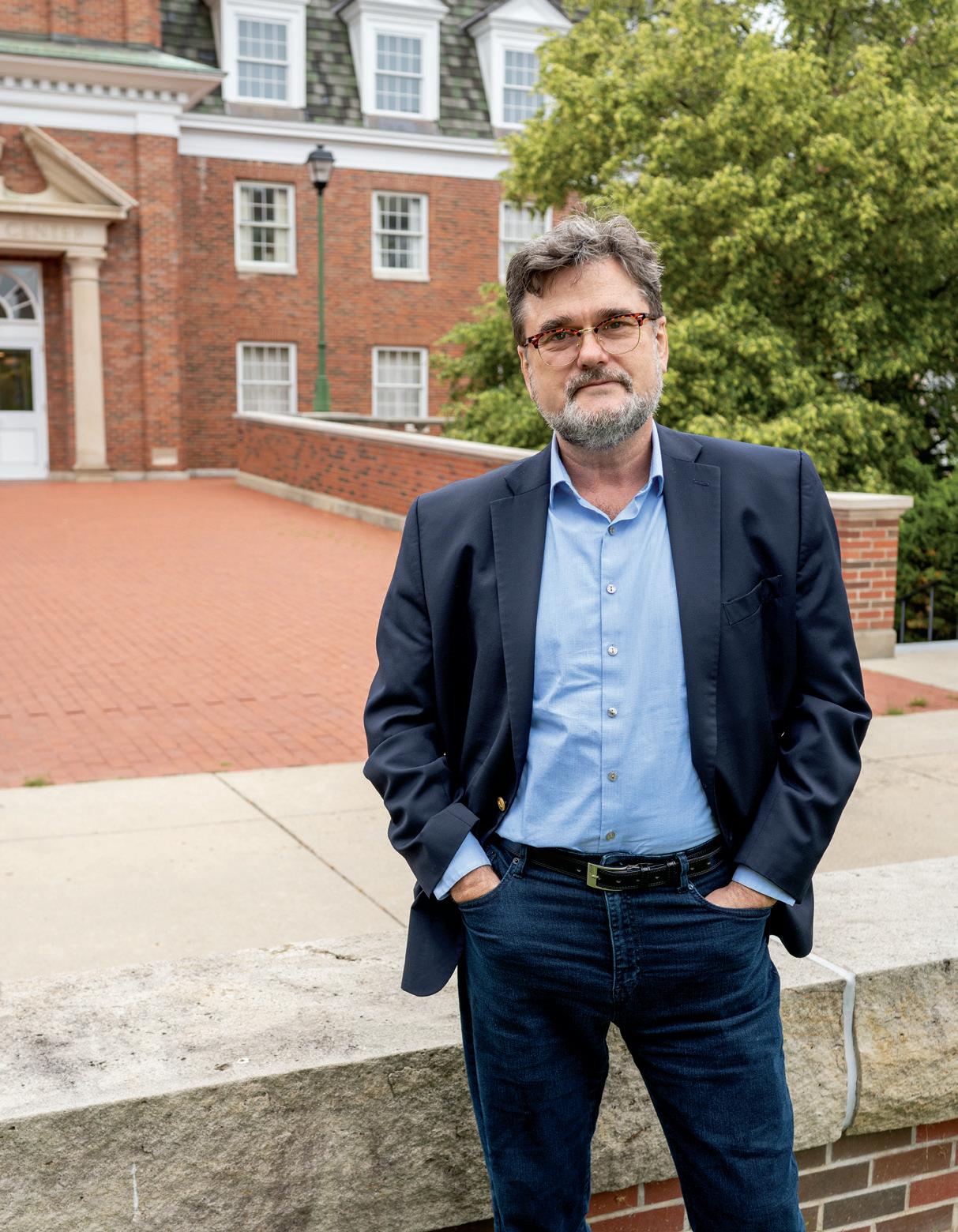
the effectiveness of his teaching methods and philosophies, and he has authored hundreds of papers and scientific reports in his field.
Nesic has lived all around the world, including former Yugoslavia, Libya, Canada, Norway and Australia. He has called Athens home since 2002, longer than any other place, naming it at the top of his list of favorite places to live.
How do you ignite your passion when you teach? There isn’t a better thing you can give someone than knowledge. My joy is to share what I know and do it in an open and sincere way. I feel that interacting with young people is inspiring. It always sounds like a cliche, but the curiosity [students] have, and the ability to spark something in them, is so wonderful.
How do you feel your work benefits society? I derive huge pride from seeing my students succeed. They go on to get these degrees, and then on top of those successes, they get good jobs and go forward in their careers. Learning about their successes is the moment where I feel this hot and fuzzy feeling inside that I did something right. That’s the biggest satisfaction I have in my line of work.
What keeps Athens at the top of your list of favorite places you’ve lived? I think everyone who has lived here for a while knows it, although it’s not always easy to put your finger on. But if I try, it is the whole vibe of this place. I like the fact that it’s small and that there are so many interesting people living close to each other, thanks to the University. We have all these students—the energy, the talents, the fun they bring—and then you have all these people who work at the University who are from all over the world, and they’re also interesting and fun. It has that sense of community. Somehow, we felt right at home very soon after we came. —Carmen
Szukaitis,BSJ ’24
This summer saw the discovery of a lifetime for one graduate student: David Lamp, BA ’08, unearthed a Clovis fluted point dating back to about 13,000 years ago during a summer 2023 Field School in Ohio Archaeology dig at one of two newly discovered Paleoindian sites. “It is not an overstatement to say that you would be hard-pressed to find a student at any university in the nation that has been exposed to what the students of this field school have this year,” Lamp notes. See more from this and other OHIO archaeological digs this summer in our photo essay at ohiotoday.org.

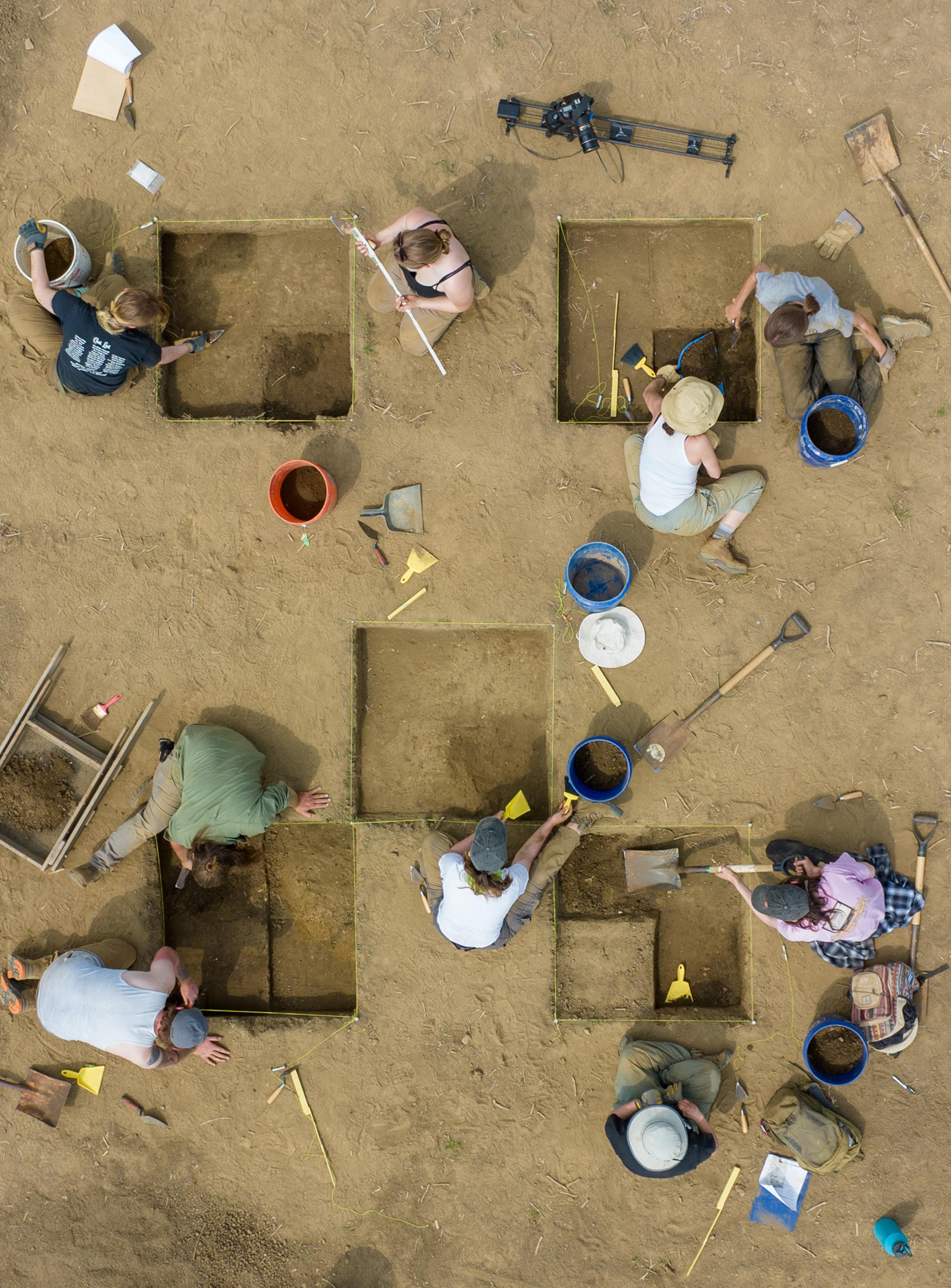
Ohio University
P.O. Box 869
1 Ohio University Drive

Athens, Ohio 45701-0869
OHIO’s fourth annual Giving Day (April 18, 2023) shattered records for 3,196 gifts in one day, raising more than $1.1 million. This year, one giving opportunity let donors symbolically name a College Green squirrel. Some of our favorite monikers of the 1,200-plus squirrels dubbed include Hot Nuts Tony, James Squirrel Jones, Tailer Swift, Squirrelterious Flufus III, Chicken of the Tree and Fluffy the Friendly Burrito Bandit. See more staff picks for silly, sentimental and creative squirrel names at ohiotoday.org
